Transforming your outdoor space into a stunning sanctuary requires more than just planting flowers and trimming hedges. Hardscaping brings structure, functionality, and lasting beauty to your yard through the thoughtful use of non-living materials like stone, concrete, brick, and wood. These permanent features create the backbone of your landscape design, providing year-round appeal while reducing maintenance needs. From elegant patios that extend your living space outdoors to practical retaining walls that solve drainage issues, hardscaping projects offer endless possibilities for enhancing both the beauty and usability of your property. Whether you have a small urban backyard or sprawling suburban grounds, the right combination of hardscaping elements can increase your home's value while creating inviting outdoor areas for relaxation and entertainment.
1. Natural Stone Patio Design
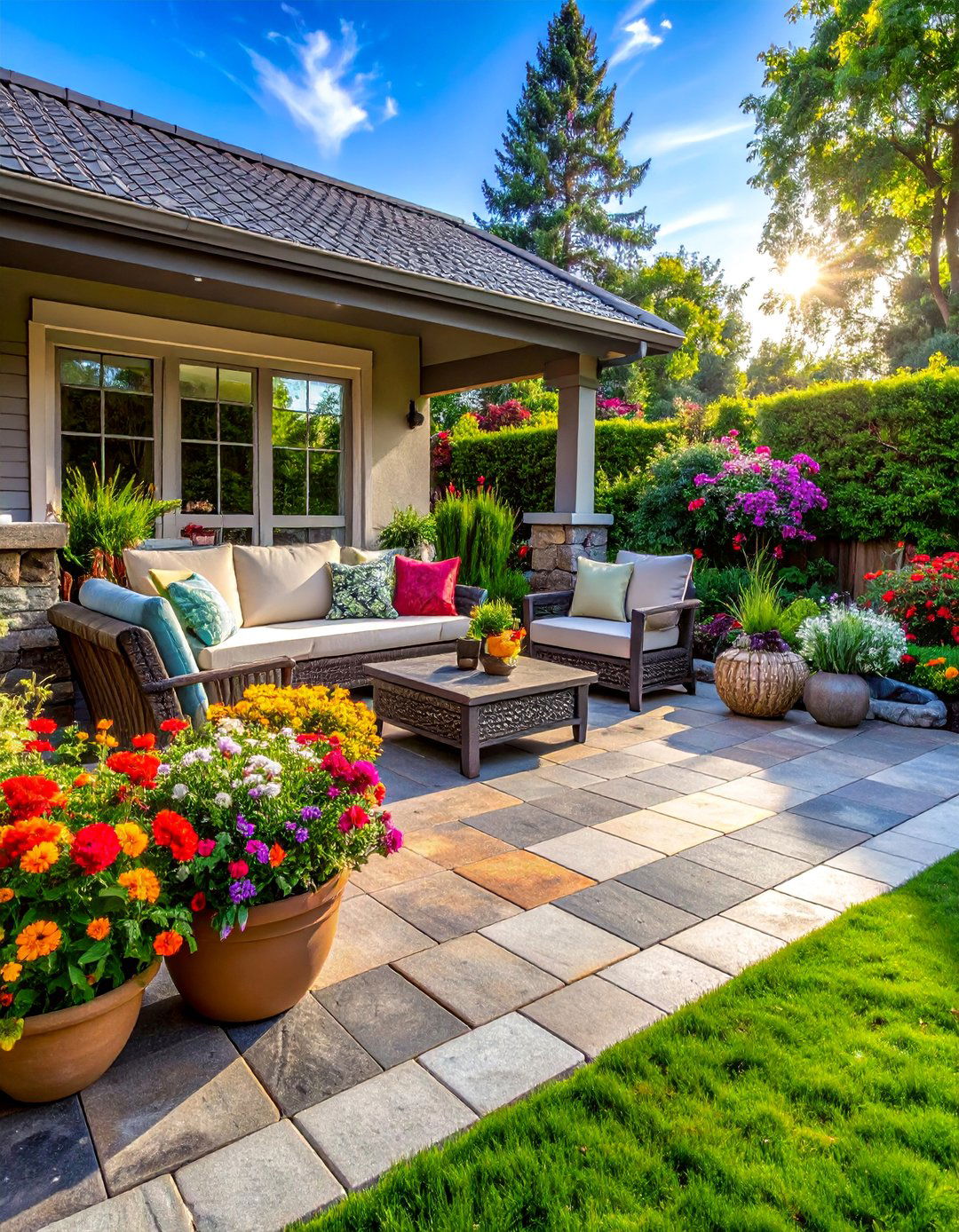
Have you ever wondered how natural stone can instantly elevate your outdoor living space? A natural stone patio creates an timeless foundation for outdoor entertaining and relaxation. This complete design approach incorporates flagstone, bluestone, or limestone laid in irregular patterns that complement your home's architecture. The organic shapes and varied textures of natural stone provide visual interest while maintaining durability against weather and heavy foot traffic. Surrounding the patio with low-growing plants and decorative gravel creates seamless transitions between hard and soft landscaping elements. Built-in planters using matching stone materials can define seating areas while adding greenery. This hardscaping theme works particularly well with traditional or rustic home styles, creating an outdoor room that feels both sophisticated and naturally integrated into the landscape.
2. Modern Concrete Paver Systems
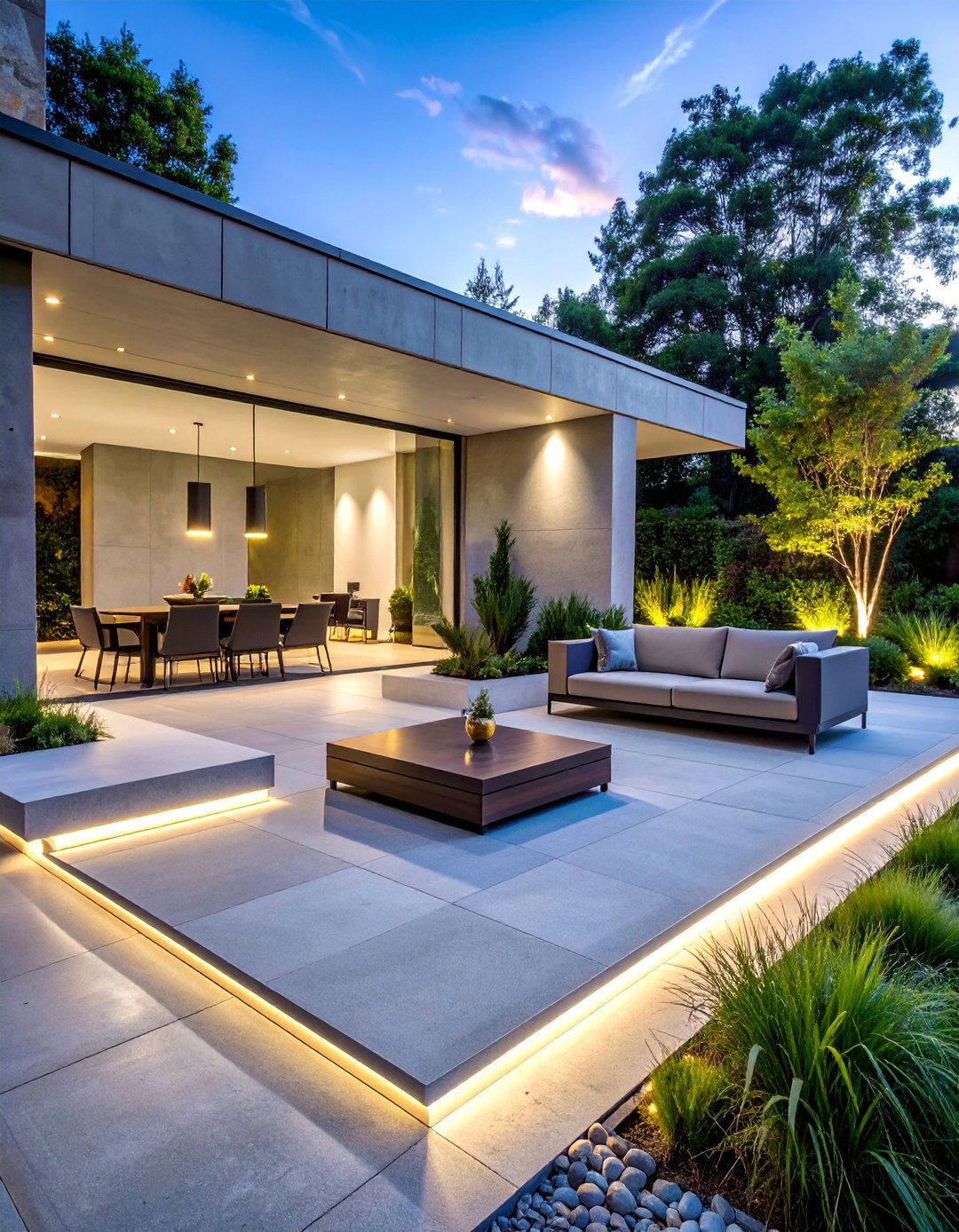
What makes concrete pavers so versatile for contemporary outdoor designs? Modern concrete paver systems offer clean lines and geometric patterns perfect for minimalist landscapes. This design theme features large-format pavers in neutral colors like charcoal, beige, or white, arranged in linear or grid patterns that emphasize simplicity and order. The smooth surfaces and precise edges create visual continuity when extended from indoor flooring to outdoor spaces. Integrated lighting strips between paver joints provide subtle illumination for evening use. Low-maintenance landscaping with ornamental grasses and architectural plants in sleek planters complements the modern aesthetic. This hardscaping approach works exceptionally well with contemporary homes, creating sophisticated outdoor living areas that require minimal upkeep while maximizing style and functionality.
3. Curved Brick Walkway Designs
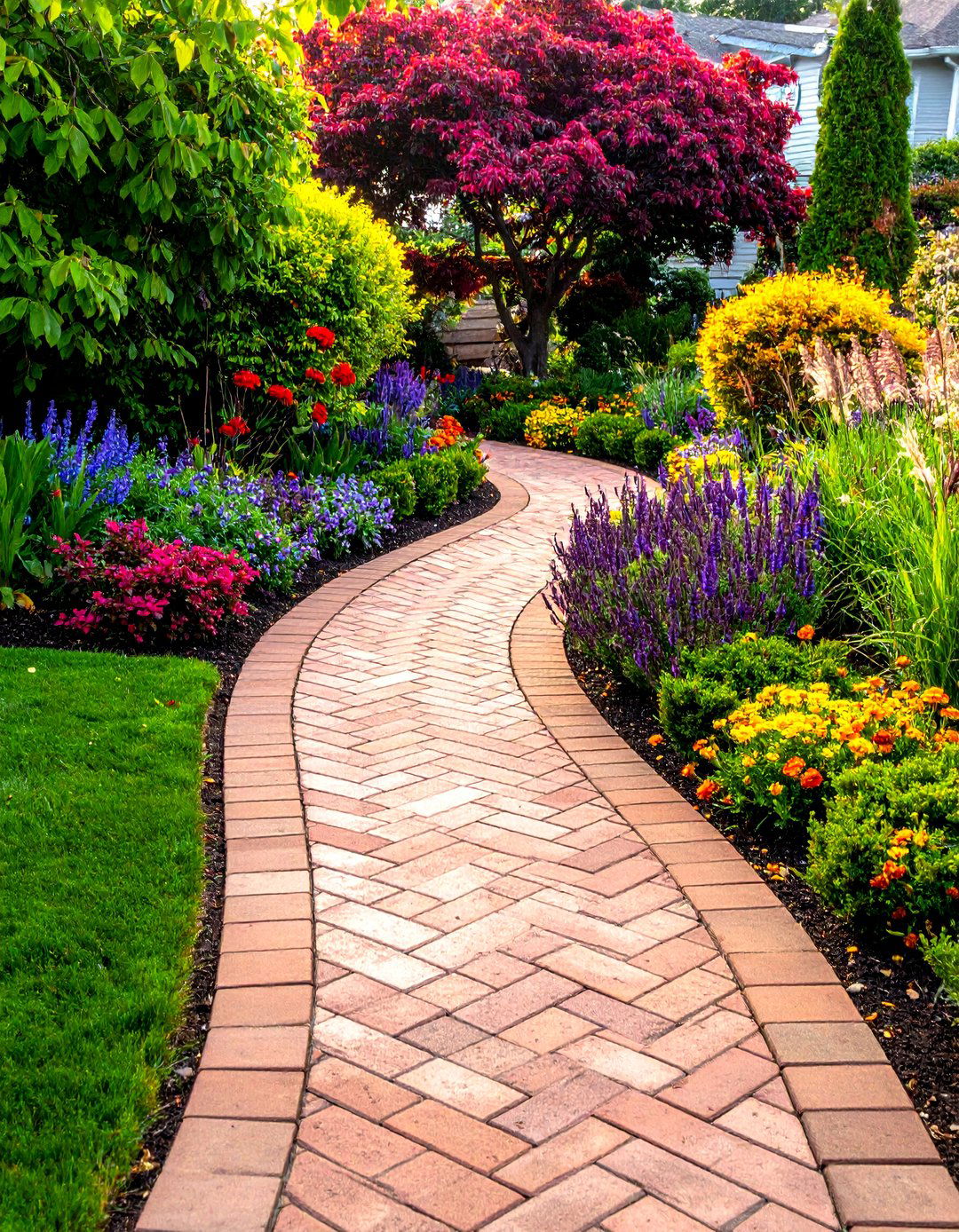
Why do curved pathways create such welcoming approaches to your home? Curved brick walkways add classic charm and graceful movement through your landscape. This traditional design theme uses clay or concrete bricks laid in herringbone, basket weave, or running bond patterns that guide visitors along a gentle, meandering route. The warm red and brown tones of brick complement both formal and cottage-style gardens beautifully. Curved edges soften the hardscape while creating opportunities for planting beds filled with perennials and seasonal flowers. Border plantings of boxwood or lavender define the pathway while adding fragrance and color. This timeless hardscaping solution enhances curb appeal while providing practical access routes that feel more inviting than straight, formal paths through your outdoor space.
4. Multi-Level Retaining Wall Systems
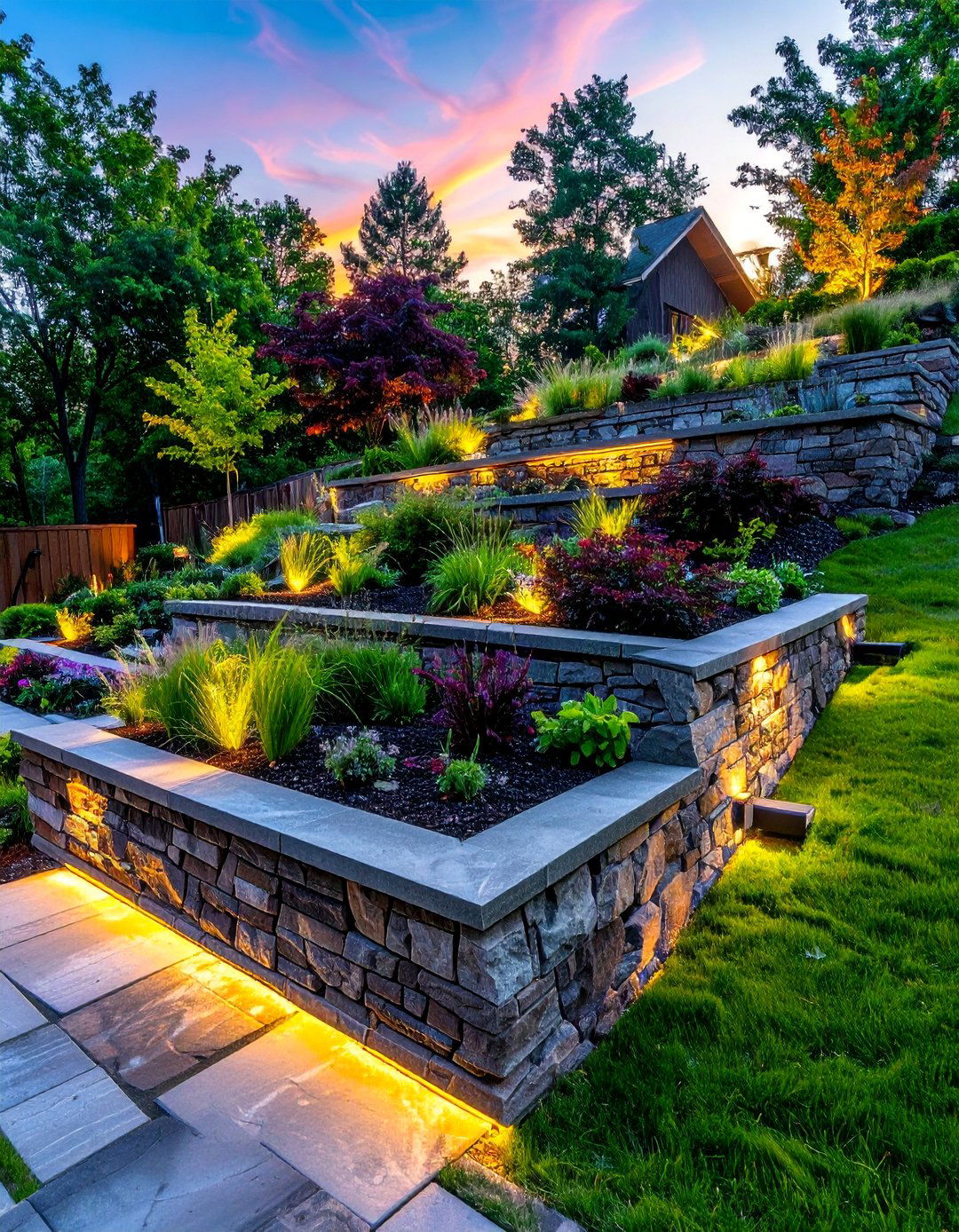
How can sloped yards become functional outdoor living spaces? Multi-level retaining wall systems transform challenging terrain into usable terraced areas perfect for gardens, seating, and entertainment. This engineering-focused design uses concrete blocks, natural stone, or timber to create stepped levels that follow your property's natural contours. Each terrace provides flat space for specific uses like dining areas, garden beds, or children's play zones. Proper drainage systems behind the walls ensure long-term stability while preventing water damage. Integrated planters and built-in seating maximize functionality while maintaining visual appeal. Strategic lighting highlights the wall faces and creates dramatic evening effects. This comprehensive hardscaping approach solves practical problems while adding architectural interest that increases property value and creates multiple outdoor living zones.
5. Pergola-Covered Outdoor Dining Areas
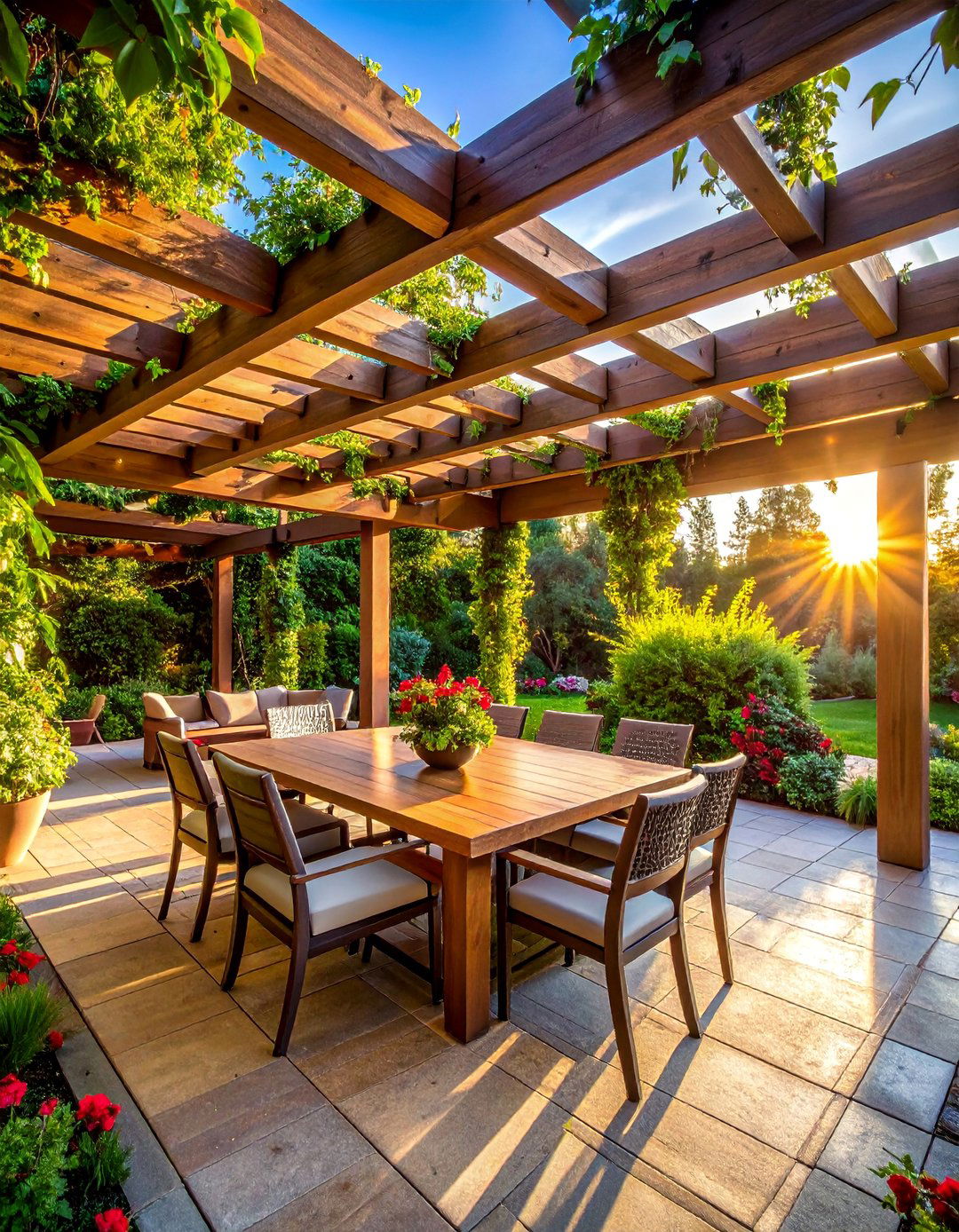
What transforms an ordinary patio into an elegant outdoor dining room? A pergola-covered dining area combines structural beauty with practical shade for year-round outdoor entertaining. This complete design features timber or aluminum pergola frames supporting climbing vines or retractable canopies that provide adjustable sun protection. The dining space beneath includes weather-resistant furniture positioned on durable paving materials like natural stone or high-quality concrete pavers. Built-in planters around the perimeter soften the structure while providing privacy from neighboring properties. Outdoor lighting integrated into the pergola beams creates ambient illumination for evening meals. This hardscaping theme works well with various architectural styles, creating dedicated outdoor rooms that feel intimate and protected while maintaining connection to the surrounding landscape and garden areas.
6. Fire Pit Gathering Spaces
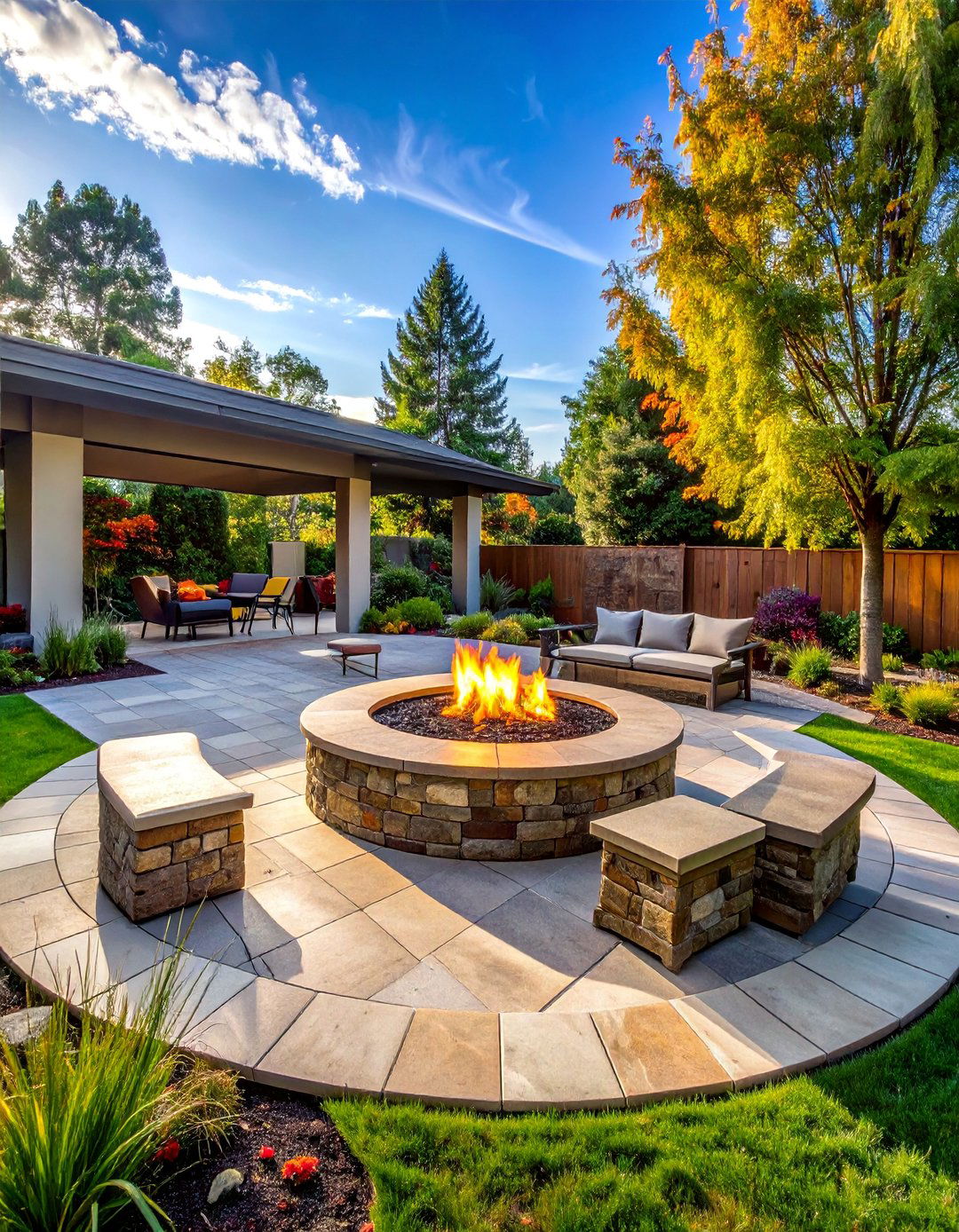
Does your backyard lack a focal point for evening entertainment? A fire pit gathering space creates a magnetic center for family and social activities throughout multiple seasons. This design theme combines a central fire feature with comfortable seating arrangements using natural stone, concrete, or metal fire bowls surrounded by built-in benches or moveable outdoor furniture. The hardscaping includes heat-resistant paving materials like flagstone or concrete pavers that can withstand high temperatures safely. Surrounding landscape beds with low-growing plants and decorative rocks create visual boundaries while maintaining fire safety clearances. Pathways connecting the fire pit to other outdoor areas ensure easy access and flow. This comprehensive hardscaping solution extends outdoor living seasons while creating memorable gathering spaces that encourage relaxation and conversation under the stars.
7. Stepped Garden Terraces
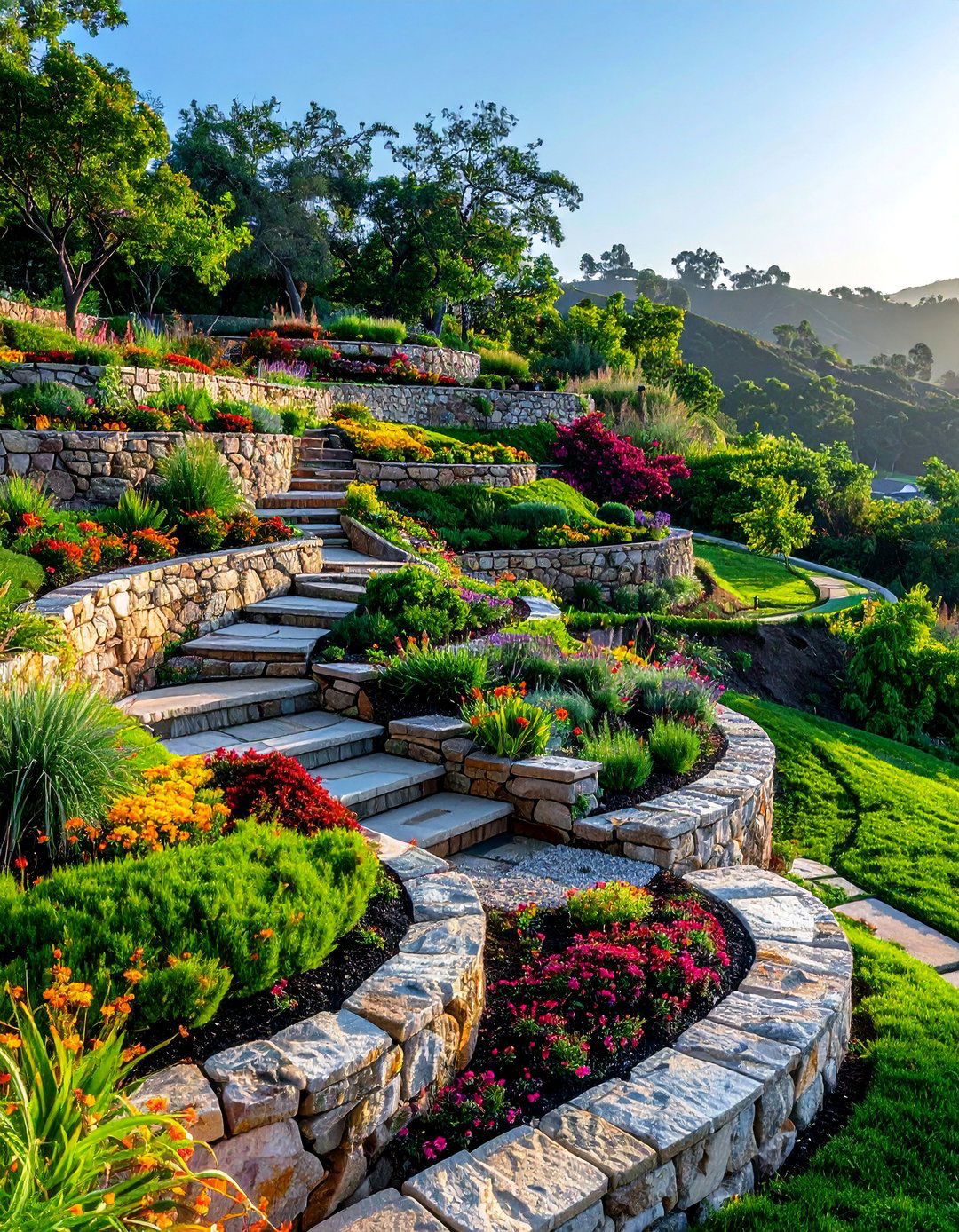
How do you create beautiful gardens on steep slopes? Stepped garden terraces use retaining walls and level planting areas to transform difficult terrain into productive growing spaces. This agricultural-inspired design combines functional stone or concrete block walls with fertile planting beds that follow your property's natural grade changes. Each terrace level provides proper drainage and soil depth for different types of plants, from vegetables and herbs to ornamental flowers and shrubs. Stone or gravel pathways between levels ensure easy access for maintenance and harvesting. Built-in irrigation systems can be integrated into the wall construction for efficient watering. This hardscaping approach maximizes planting space while preventing soil erosion, creating both practical and beautiful outdoor areas that produce food or flowers while adding significant visual interest to sloped properties.
8. Gravel Garden Pathways
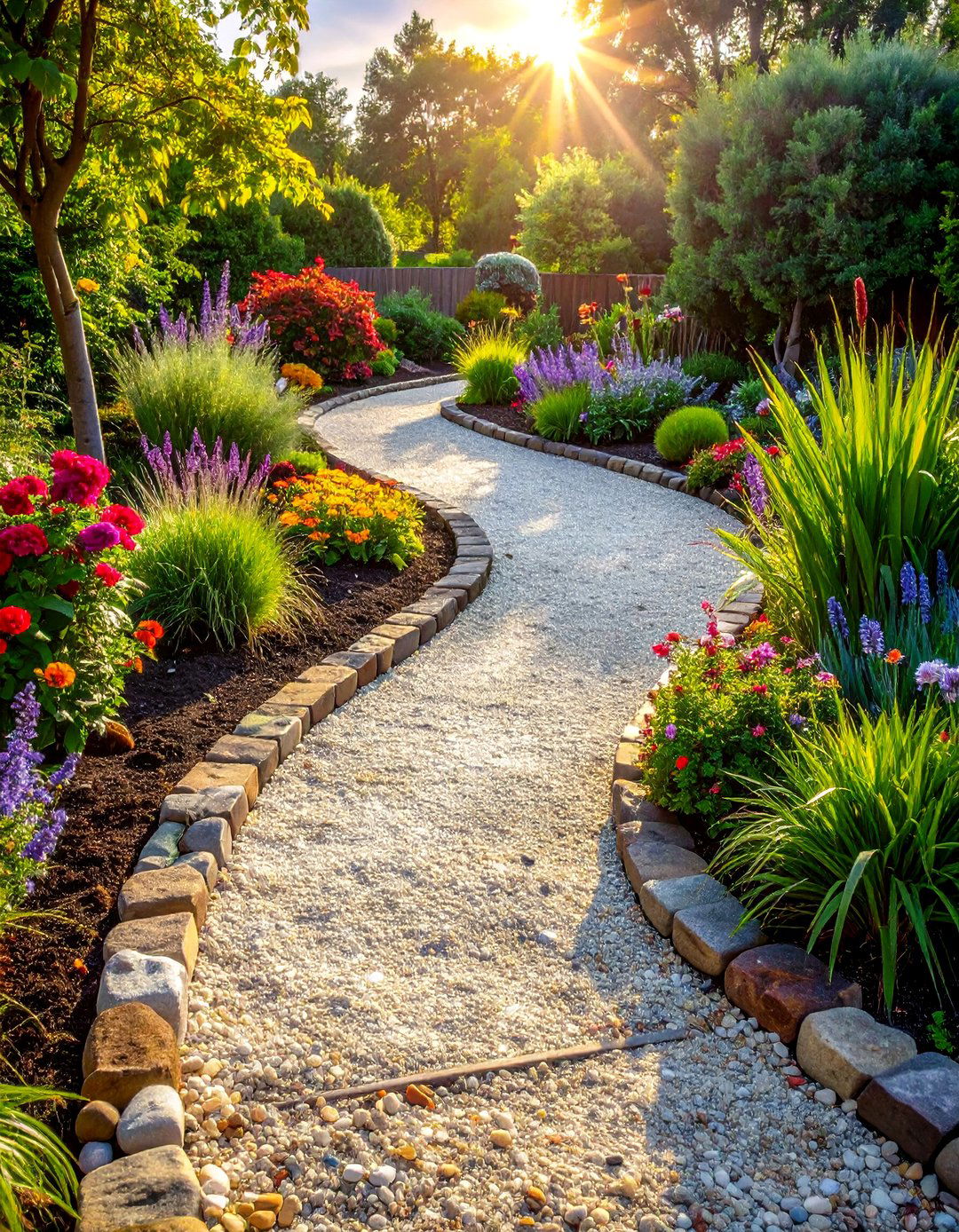
What makes gravel such an appealing choice for garden paths? Gravel pathways offer affordability, drainage, and natural texture that complements both formal and informal garden designs. This permeable hardscaping solution uses crushed stone, pea gravel, or decorative aggregate in colors ranging from neutral beige to dramatic charcoal. The pathways curve gently through planted areas, creating exploration opportunities while providing practical access routes. Edging materials like steel, stone, or timber define the path boundaries while preventing gravel migration into garden beds. Strategic placement of larger boulders or stepping stones adds visual interest and creates resting spots along longer routes. This low-maintenance hardscaping theme works particularly well in drought-tolerant gardens, providing excellent drainage while creating informal pathways that feel naturally integrated into the landscape.
9. Outdoor Kitchen Islands
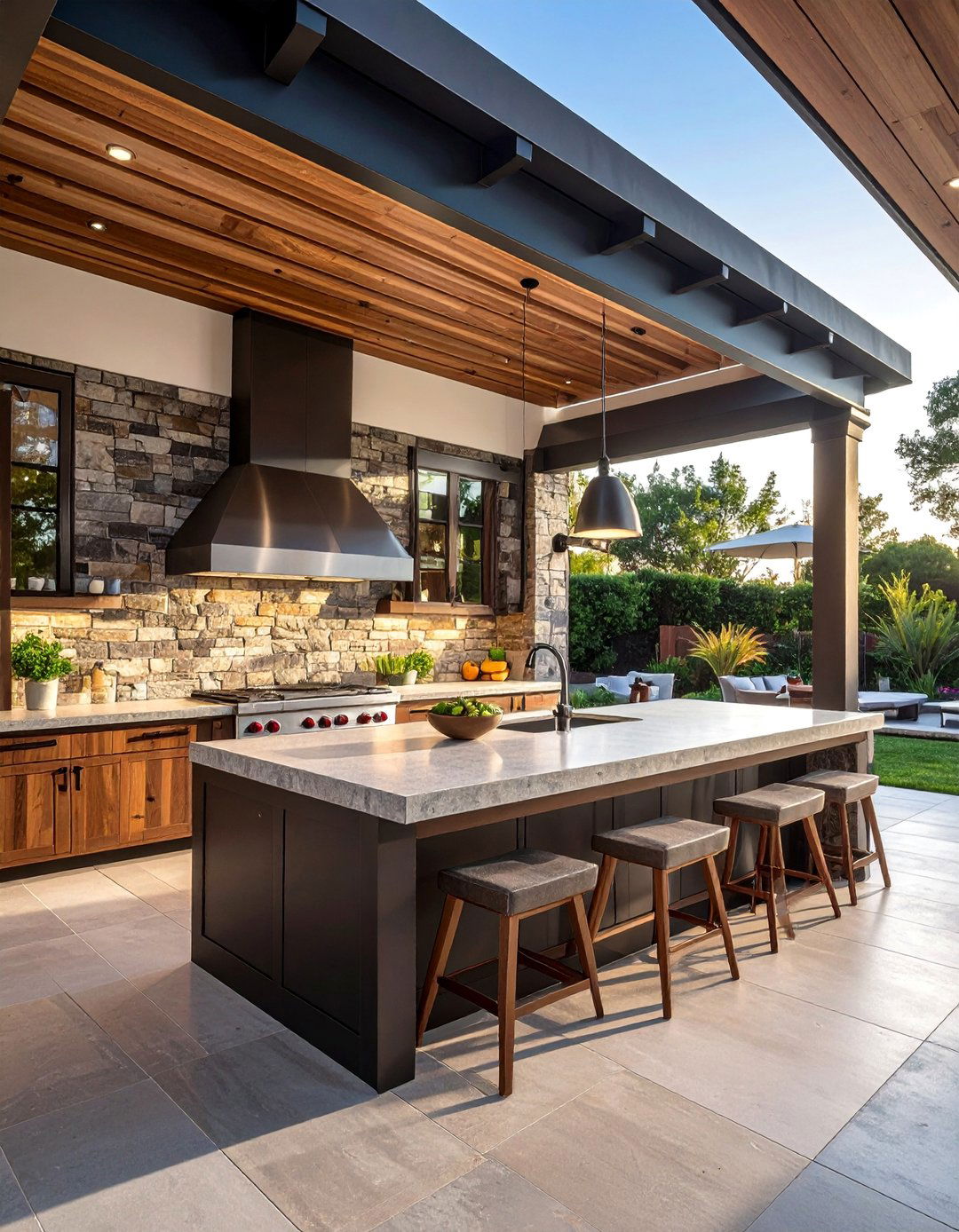
Why settle for simple grilling when you can create a complete outdoor culinary experience? Outdoor kitchen islands combine cooking, preparation, and storage functions in weatherproof hardscaping structures. This comprehensive design features stone, brick, or concrete construction with built-in grills, refrigeration, and counter space for food preparation. Overhead structures provide shade and weather protection while housing ventilation systems and lighting. Surrounding patio areas with dining furniture create seamless transitions from cooking to serving and eating outdoors. Built-in planters with herbs and vegetables provide fresh ingredients while adding greenery to the cooking space. This sophisticated hardscaping solution requires professional installation but creates resort-quality outdoor entertaining areas that significantly increase property value while extending indoor living functions into beautiful outdoor settings.
10. Water Feature Integration
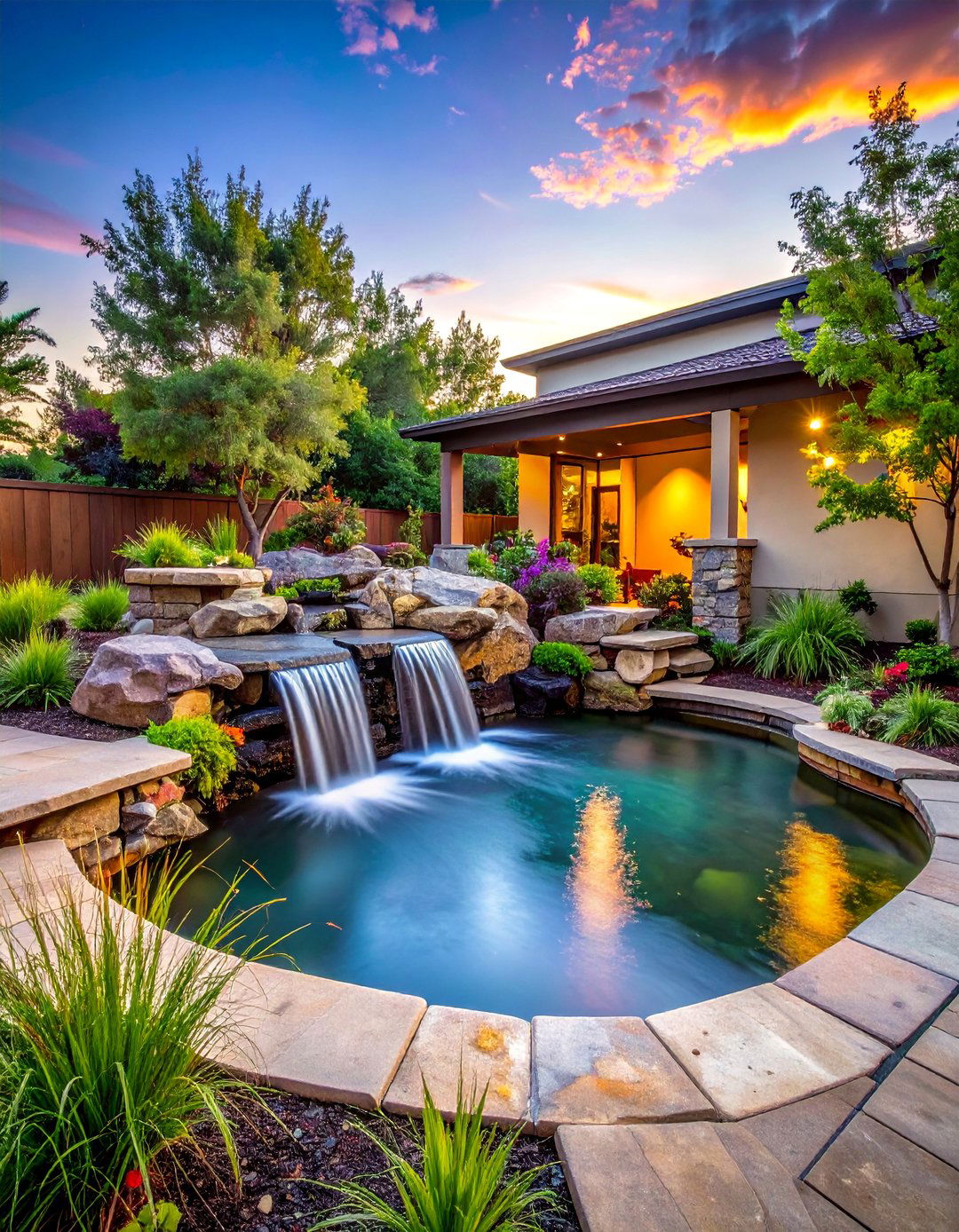
How can water elements enhance your hardscape design? Integrated water features combine the soothing sounds and visual appeal of moving water with structural hardscaping elements. This design theme incorporates fountains, streams, or waterfalls into retaining walls, patio edges, or garden borders using natural stone, concrete, or metal construction. Recirculating pumps and filtration systems maintain water quality while minimizing maintenance requirements. Surrounding plantings of moisture-loving plants like ferns and hostas create lush micro-environments that contrast beautifully with hard surfaces. Underwater lighting extends enjoyment into evening hours while creating dramatic visual effects. This comprehensive approach combines multiple hardscaping elements with water features to create focal points that provide both visual and auditory interest, enhancing outdoor relaxation while adding significant aesthetic value to any landscape design.
11. Driveway Border Enhancements
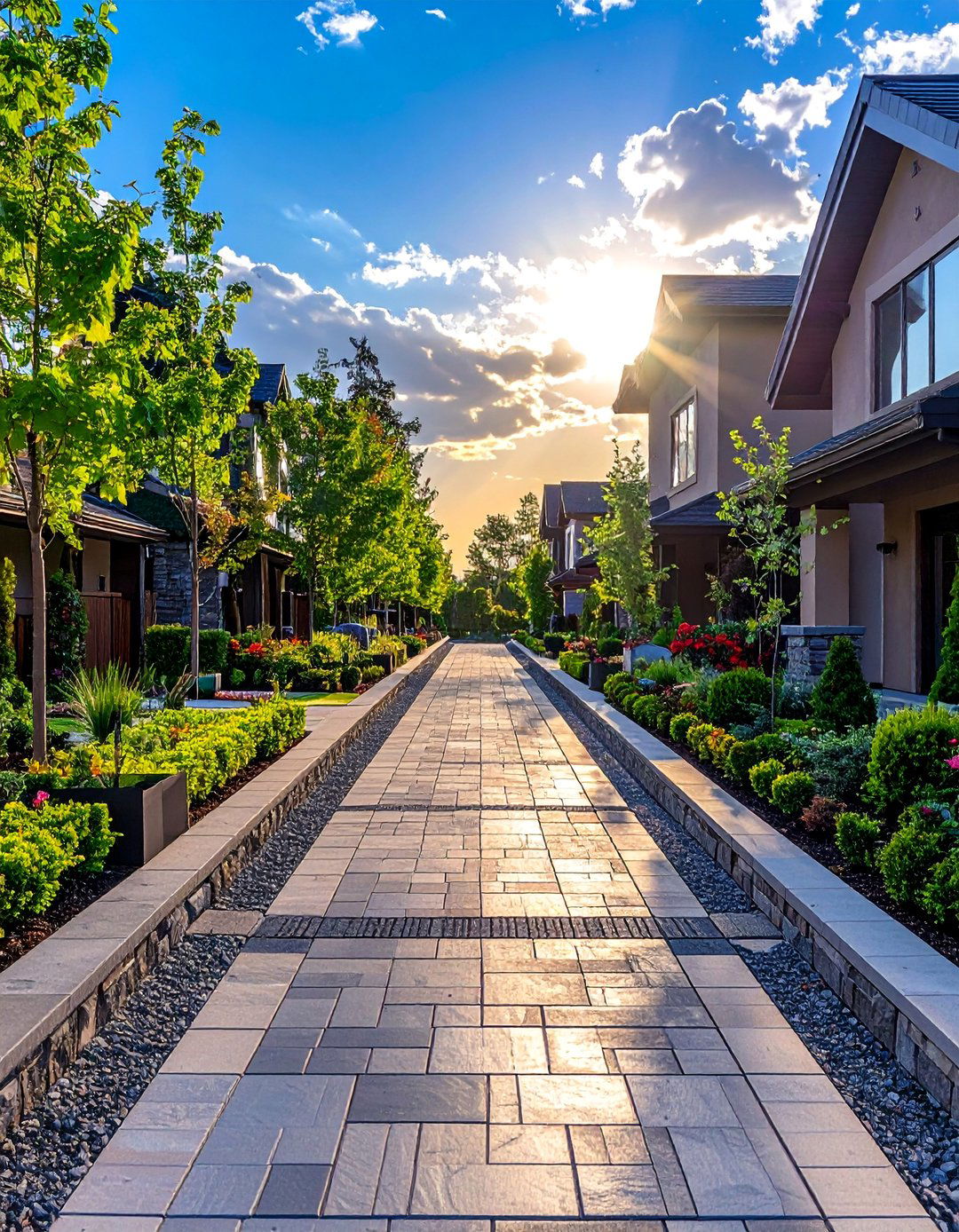
What can transform a plain driveway into an attractive landscape feature? Driveway border enhancements use hardscaping materials to frame and beautify vehicular access areas. This practical design approach combines decorative edging materials like brick, stone, or concrete with planted borders that soften the transition between pavement and lawn or garden areas. Low-growing shrubs, ornamental grasses, and seasonal flowers create year-round color while requiring minimal maintenance. Decorative lighting along the borders improves nighttime visibility and safety while adding curb appeal. Permeable materials like gravel or permeable pavers in border areas help manage stormwater runoff effectively. This hardscaping theme works with any architectural style, creating polished approaches to your home while solving practical drainage and maintenance issues around driveways and parking areas.
12. Pool Deck Surroundings
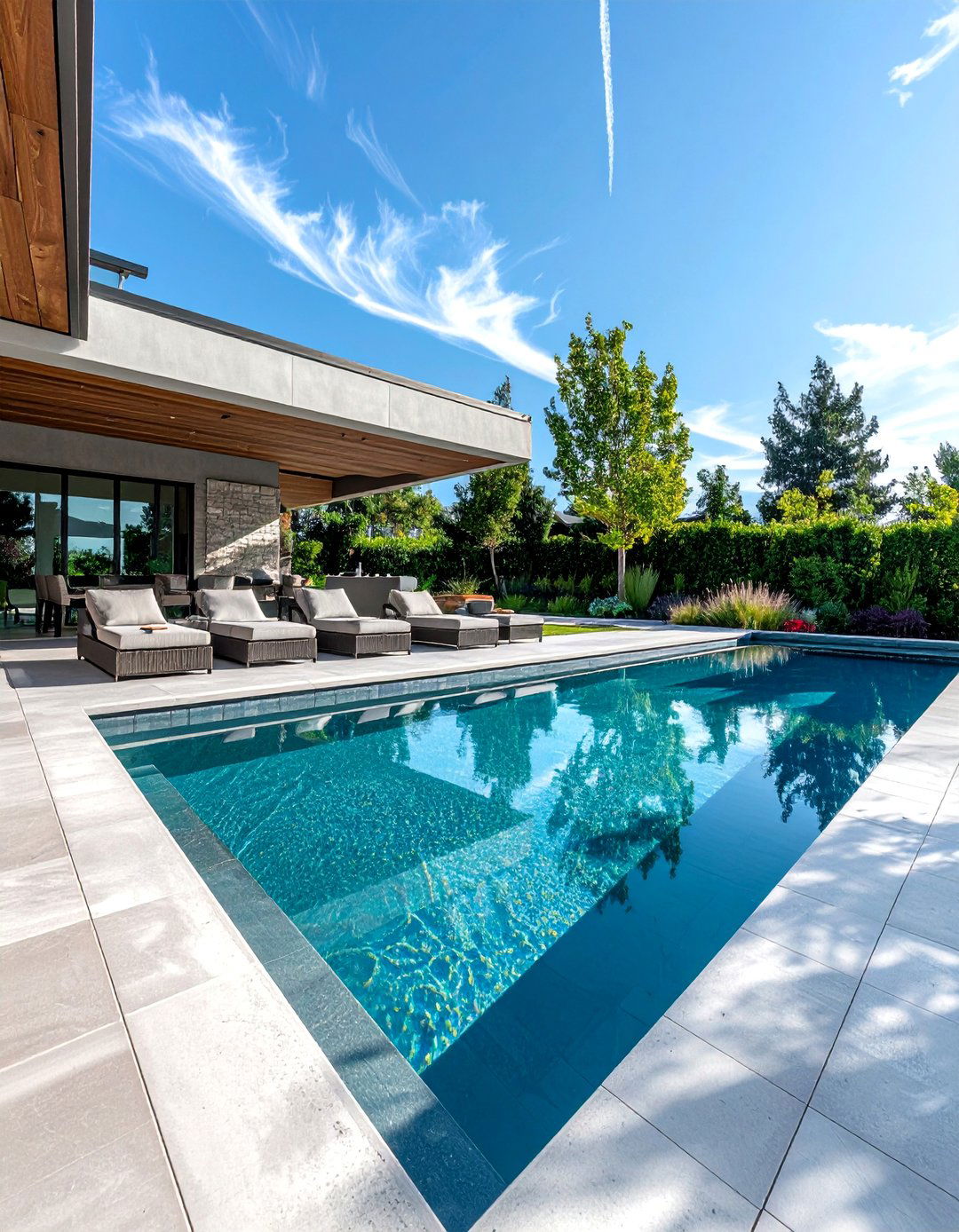
How do you create safe and beautiful pool areas? Pool deck hardscaping combines slip-resistant materials with aesthetic appeal for functional aquatic environments. This specialized design uses materials like textured concrete, natural stone, or composite decking that provide secure footing when wet while withstanding pool chemicals and UV exposure. Built-in seating areas and planters create comfortable lounging spaces while adding visual interest around the pool perimeter. Shade structures like pergolas or umbrellas provide sun protection during peak hours. Drainage systems prevent water accumulation while directing runoff away from pool equipment and structures. Landscape lighting enhances safety and ambiance for evening swimming and entertaining. This comprehensive hardscaping approach creates resort-quality pool environments that prioritize both safety and beauty while providing durable surfaces that withstand heavy use and weather exposure.
13. Entry Courtyard Designs
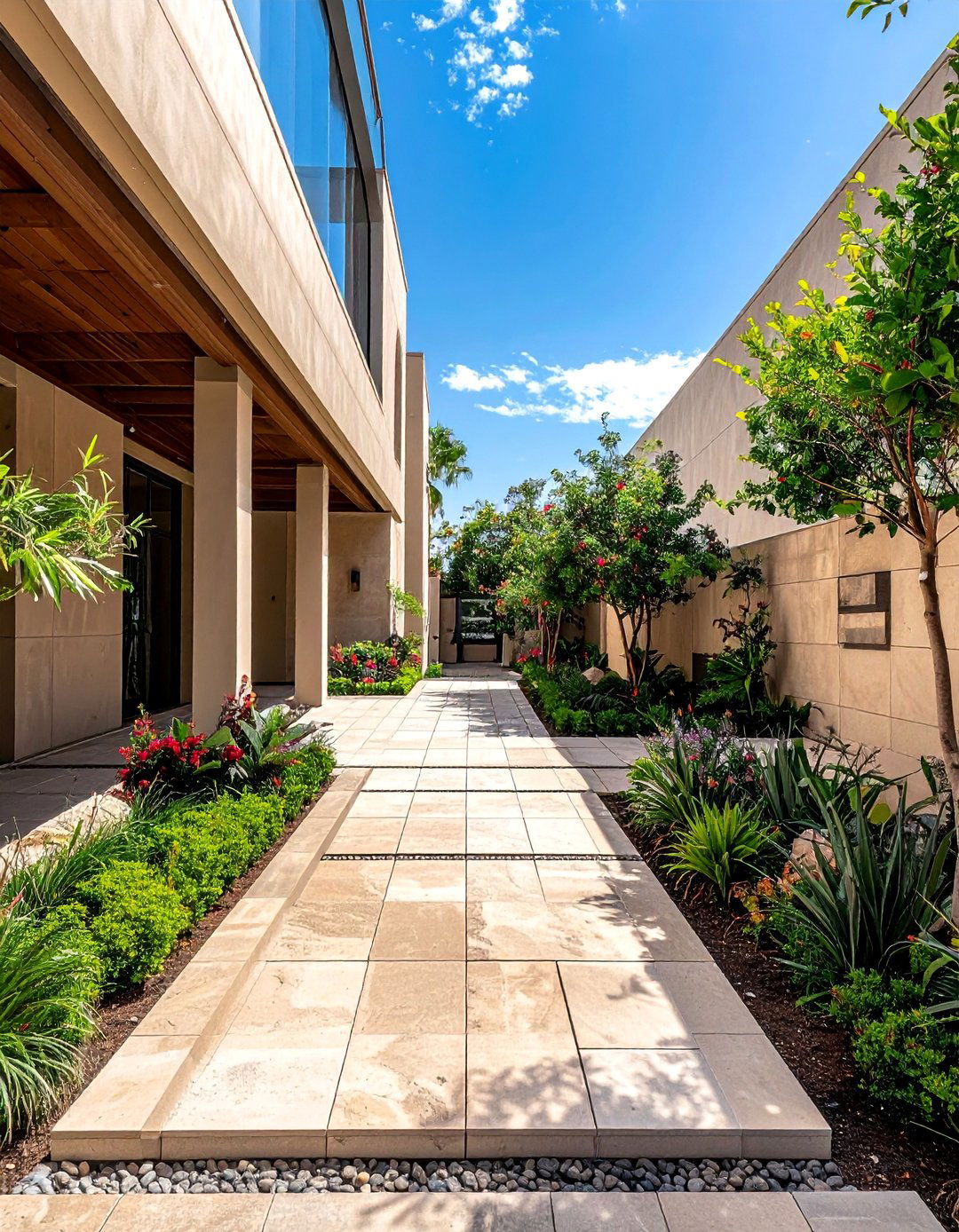
What creates a welcoming first impression for visitors to your home? Entry courtyard designs use enclosed or semi-enclosed hardscaping to create transition spaces between public and private areas. This architectural approach combines paving materials, walls, and plantings to define welcoming outdoor rooms near main entrances. Natural stone, brick, or decorative concrete creates durable flooring that complements your home's exterior materials. Low walls or planters provide privacy screening while maintaining visual connection to the surrounding landscape. Built-in seating areas encourage pause and contemplation while architectural lighting highlights key features. Water elements like fountains add soothing sounds while creating focal points. This sophisticated hardscaping theme works particularly well with traditional and contemporary homes, creating impressive entry experiences that increase curb appeal while providing functional outdoor spaces for greeting guests.
14. Raised Planting Beds
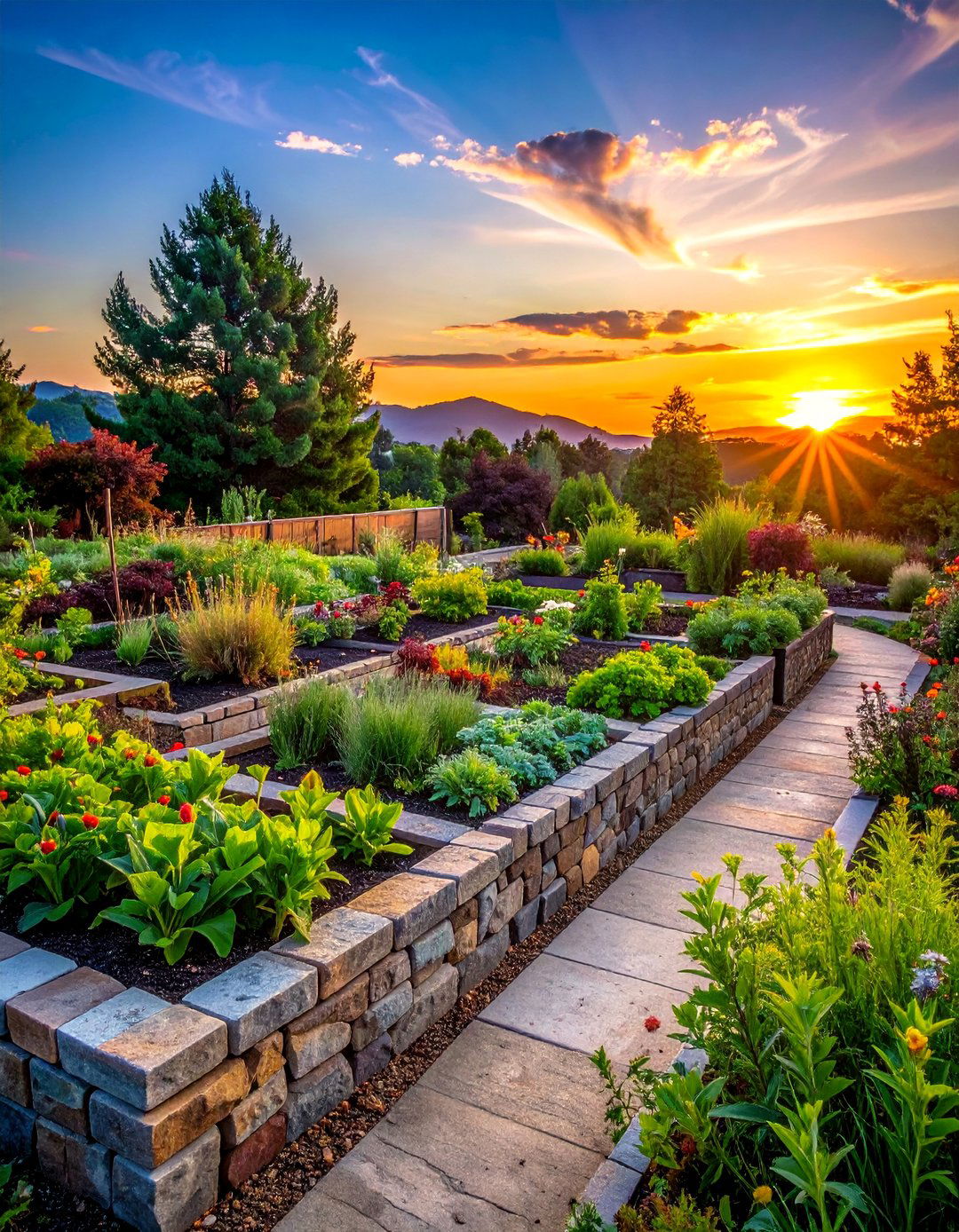
Why are raised beds becoming so popular in modern landscapes? Raised planting bed hardscaping creates defined growing areas that improve soil drainage while reducing maintenance requirements. This practical design uses stone, concrete blocks, or timber to construct elevated planters that separate growing areas from lawn and pathway surfaces. The raised construction improves soil quality control while making planting and harvesting more comfortable by reducing bending and kneeling. Built-in irrigation systems and drainage layers ensure optimal growing conditions for vegetables, herbs, or ornamental plants. Pathways between beds use gravel, mulch, or paving materials that provide clean access while suppressing weeds. This functional hardscaping approach maximizes growing space while creating organized, attractive garden areas that require less weeding and pest management than traditional ground-level planting beds.
15. Shade Structure Integration
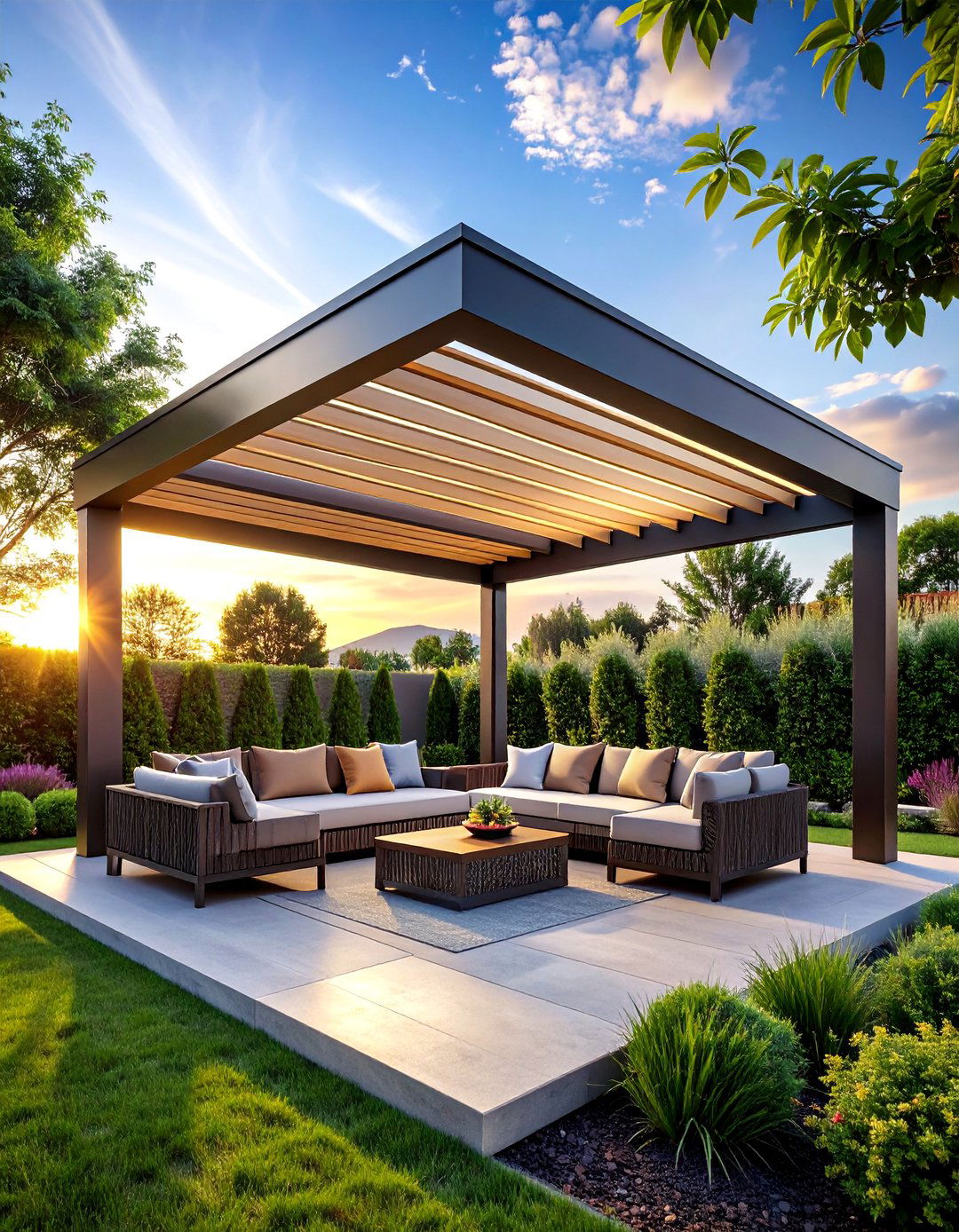
How can hardscaping provide relief from intense sun exposure? Integrated shade structures combine architectural elements with paving and landscaping to create comfortable outdoor refuges. This design theme uses pergolas, gazebos, or sail shades supported by sturdy posts anchored in concrete foundations. The shaded areas beneath feature comfortable seating on weather-resistant paving materials like stone or concrete. Climbing plants on structure supports provide additional shade while adding natural beauty and seasonal interest. Built-in planters around the perimeter create privacy screening while maintaining air circulation. Lighting integrated into the structure supports evening use while creating dramatic visual effects. This comprehensive hardscaping solution extends outdoor living seasons while providing protection from harsh weather, creating inviting spaces for relaxation and entertainment that feel like outdoor rooms with natural air conditioning.
16. Decorative Wall Features
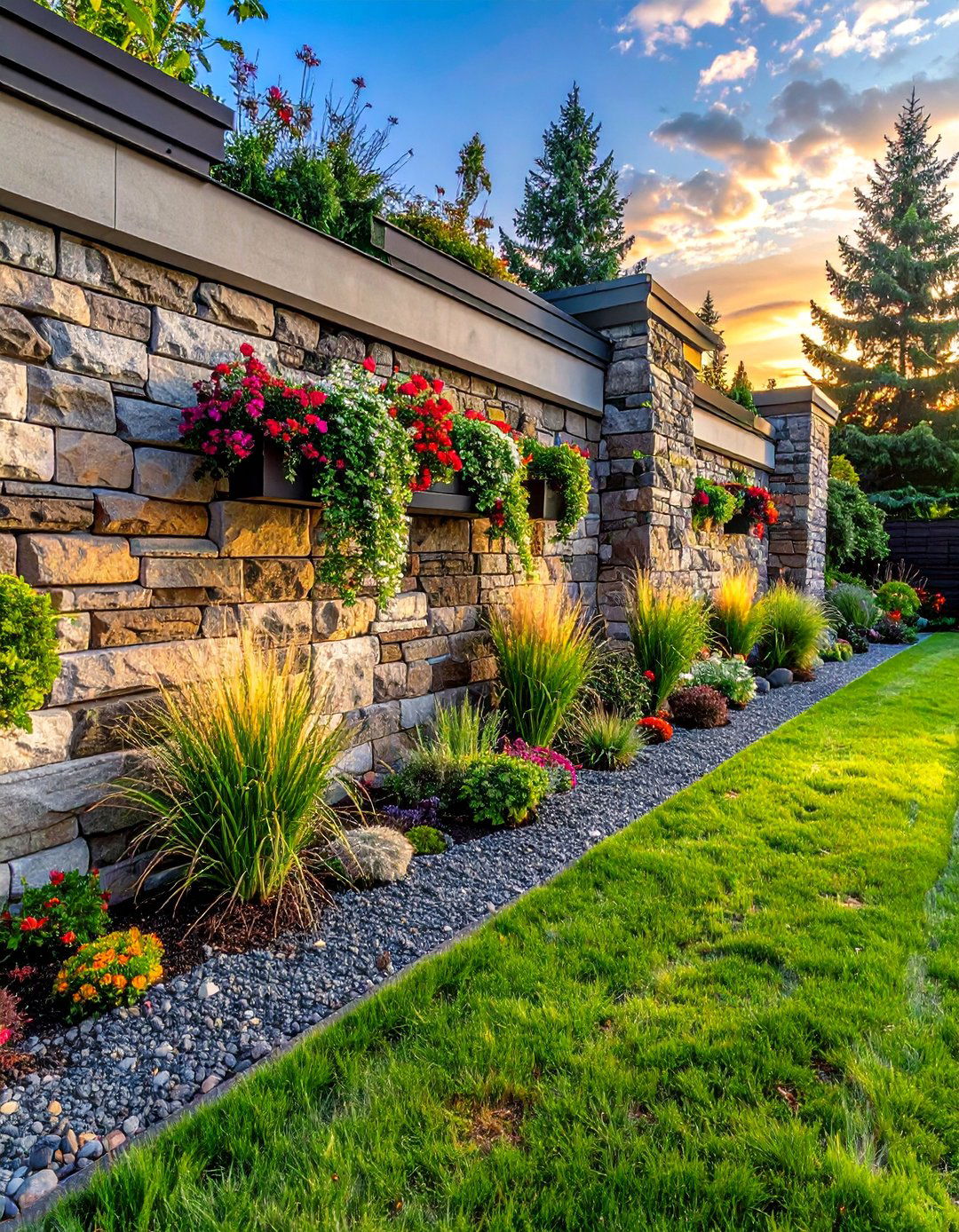
What can transform blank exterior walls into landscape assets? Decorative wall hardscaping creates vertical interest while providing practical functions like privacy and wind protection. This design approach uses materials like stacked stone, decorative concrete blocks, or timber to construct walls that complement your home's architecture. Integrated planters soften hard surfaces while providing growing space for climbing plants or cascading flowers. Built-in lighting highlights wall textures while providing security illumination. Artistic elements like mosaics, sculptural inserts, or water features add personal expression and focal point interest. Seating ledges integrated into wall design create casual gathering spots while maximizing space efficiency. This versatile hardscaping theme works with any architectural style, creating functional boundaries while adding visual interest that transforms ordinary walls into landscape features that enhance both privacy and aesthetic appeal.
17. Stepping Stone Pathways
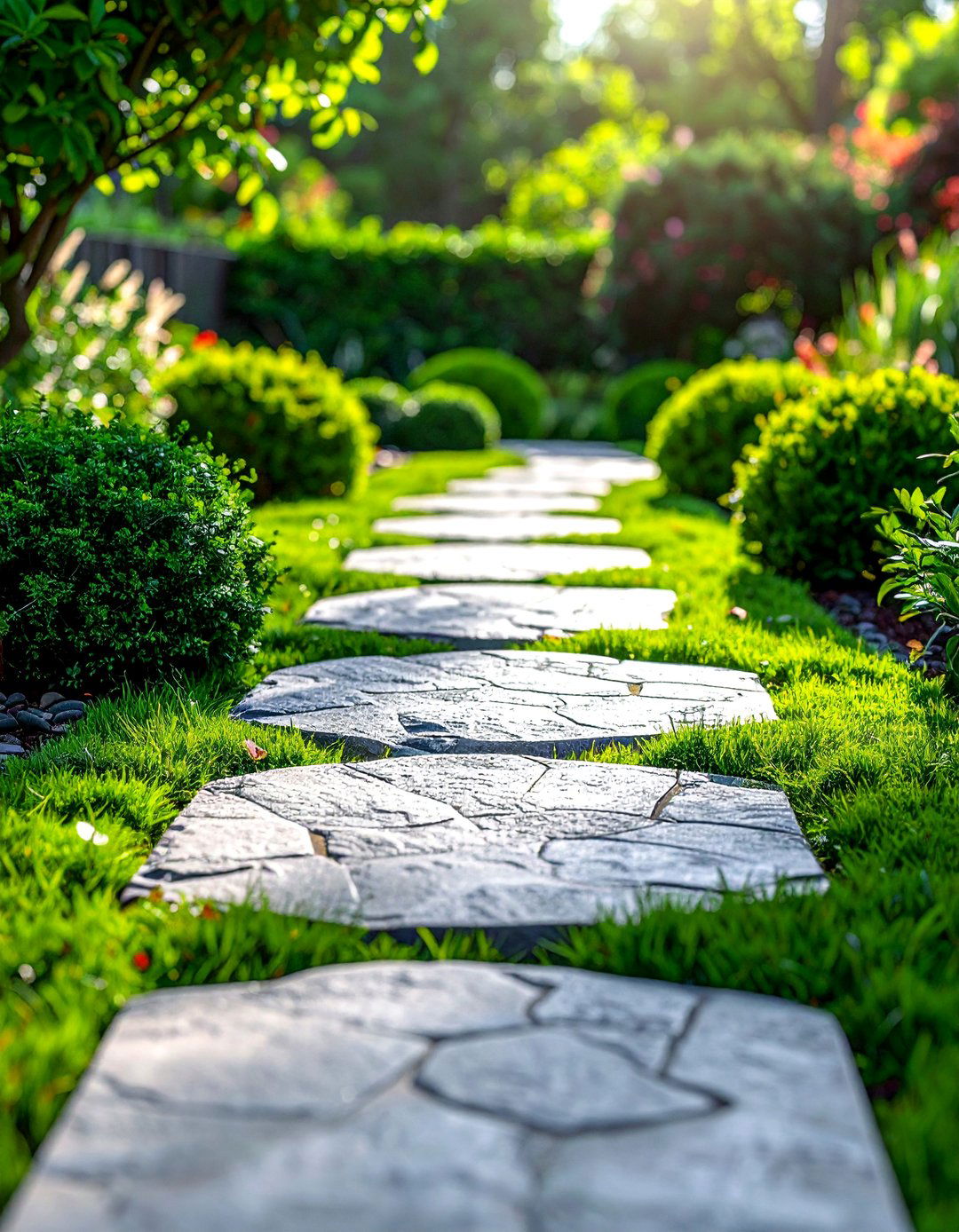
Why do stepping stone paths feel so naturally inviting? Stepping stone pathways create informal routes through gardens while allowing plants to grow between hardscape elements. This organic design approach uses natural stone, concrete pavers, or reclaimed materials placed at comfortable walking intervals through planted areas. The spacing between stones provides planting opportunities for ground covers, moss, or low-growing perennials that soften the pathway while maintaining navigation function. Irregular stone shapes and sizes create visual interest while following natural walking patterns through the landscape. Surrounding plantings of ornamental grasses, wildflowers, or woodland plants complement the informal aesthetic. This low-impact hardscaping solution works particularly well in naturalistic gardens, creating paths that feel integrated into the landscape while providing practical access routes that encourage exploration and discovery of garden areas.
18. Outdoor Seating Walls
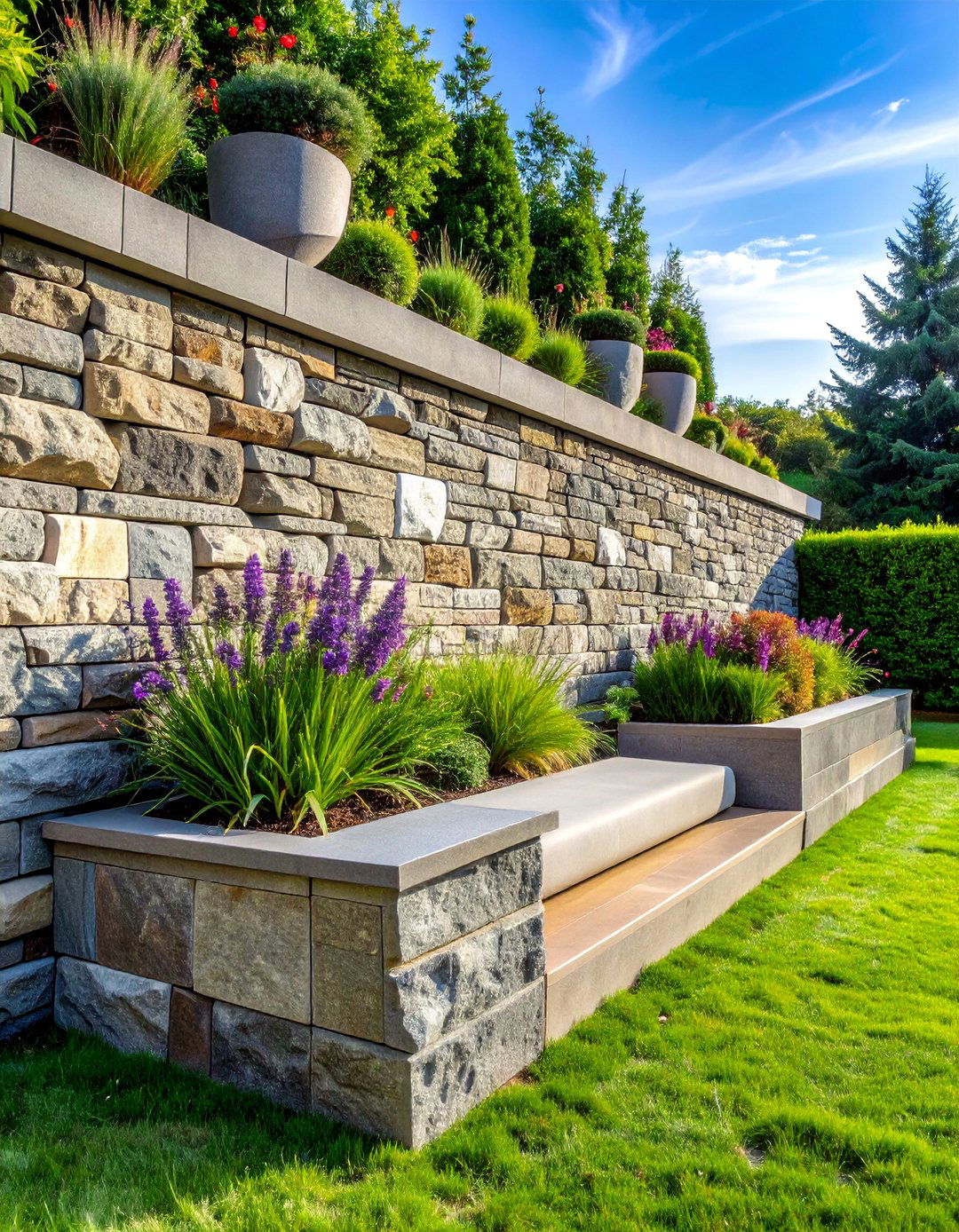
How can hardscaping provide both structure and functionality? Seating wall construction combines retaining wall engineering with comfortable outdoor furniture functions. This dual-purpose design uses stone, concrete blocks, or brick to create walls that solve slope and drainage issues while providing built-in seating for outdoor entertainment. The wall height and depth are designed for comfortable sitting while the top surface uses smooth materials or cushioning for enhanced comfort. Integrated planters behind seating areas provide back support while adding greenery and privacy screening. Built-in lighting under wall caps creates ambient illumination while highlighting the hardscape features. This efficient hardscaping approach maximizes space utility while solving multiple landscape challenges, creating functional outdoor rooms that feel naturally integrated into the overall landscape design while providing practical solutions for seating and slope management.
19. Permeable Paving Solutions
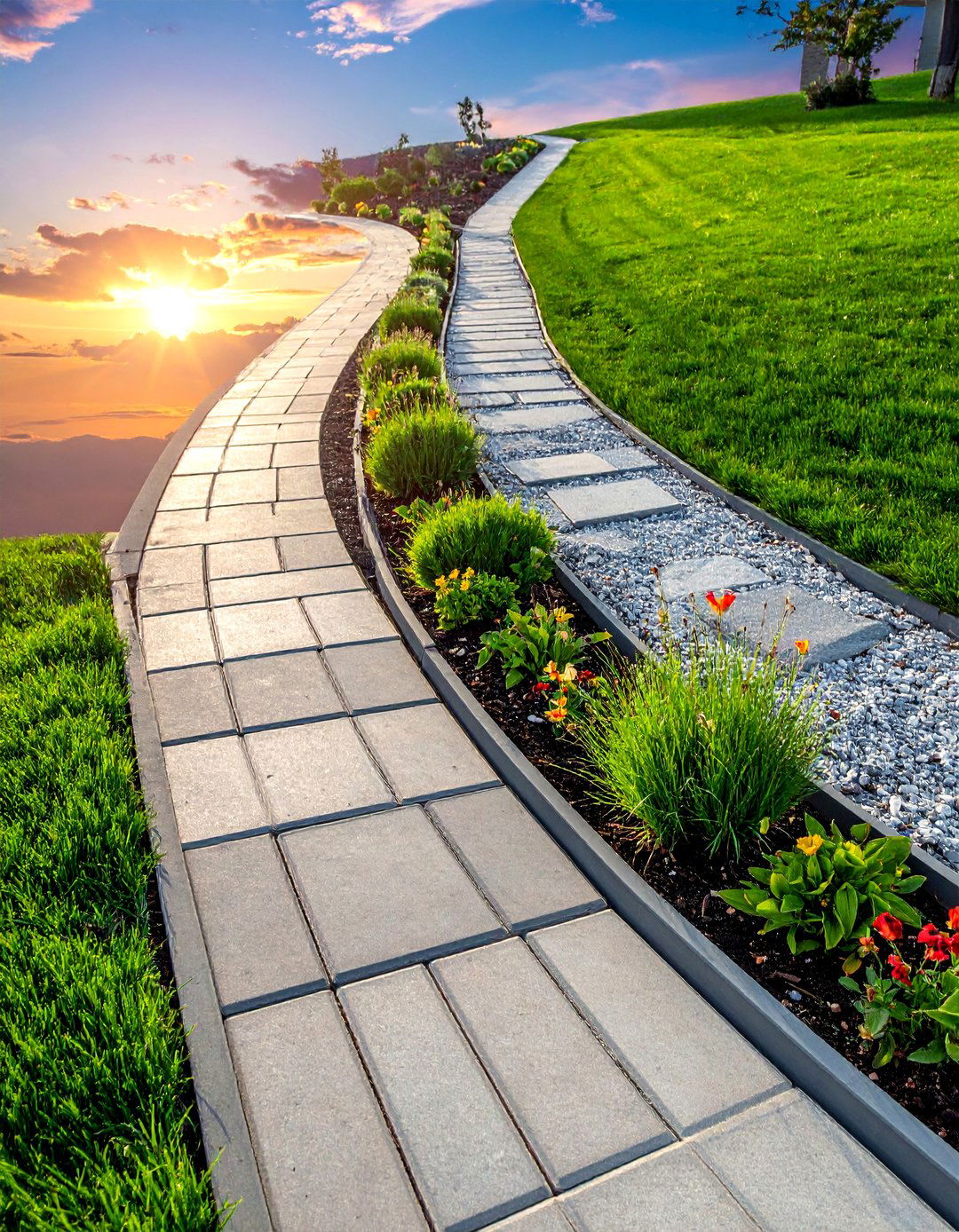
What hardscaping materials help manage stormwater while creating beautiful surfaces? Permeable paving systems allow water infiltration while providing durable surfaces for patios, driveways, and walkways. This environmentally conscious design uses materials like permeable concrete, porous pavers, or gravel-filled grid systems that reduce runoff while maintaining structural integrity. The spaces between paving elements can be filled with decorative aggregate, ground covers, or drought-tolerant plants that add color and texture. Proper base preparation ensures long-term performance while supporting environmental benefits like groundwater recharge and pollution filtration. This sustainable hardscaping approach works particularly well in areas with drainage challenges, creating beautiful outdoor surfaces that contribute to environmental stewardship while providing practical functionality for vehicles and pedestrians in residential landscape applications.
20. Rock Garden Landscapes
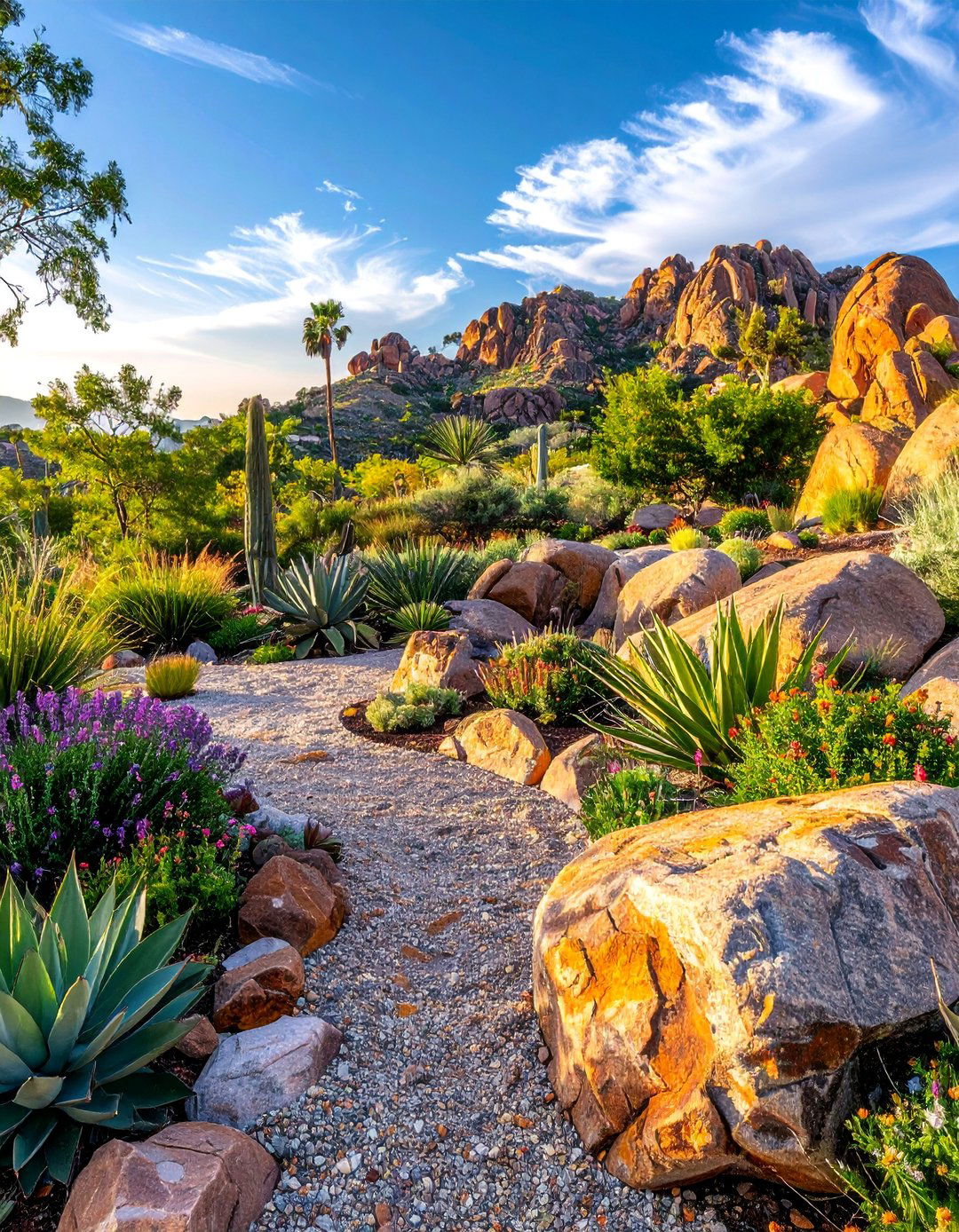
How can rocky terrain become a beautiful landscape feature? Rock garden hardscaping transforms challenging sites into low-maintenance displays of natural beauty. This geological approach uses native stones, boulders, and outcropping to create dramatic landscape features that require minimal irrigation and maintenance. Drought-tolerant plants like succulents, alpine species, and ornamental grasses thrive in the well-draining conditions between rocks. Gravel pathways wind through the rock formations, creating exploration opportunities while providing access for maintenance. Strategic placement of larger boulders creates focal points and seating areas while smaller stones fill gaps and provide planting pockets. This water-wise hardscaping theme works exceptionally well in arid climates or areas with poor soil conditions, creating stunning landscape features that celebrate natural materials while providing habitat for wildlife and requiring minimal ongoing care.
21. Circular Patio Designs
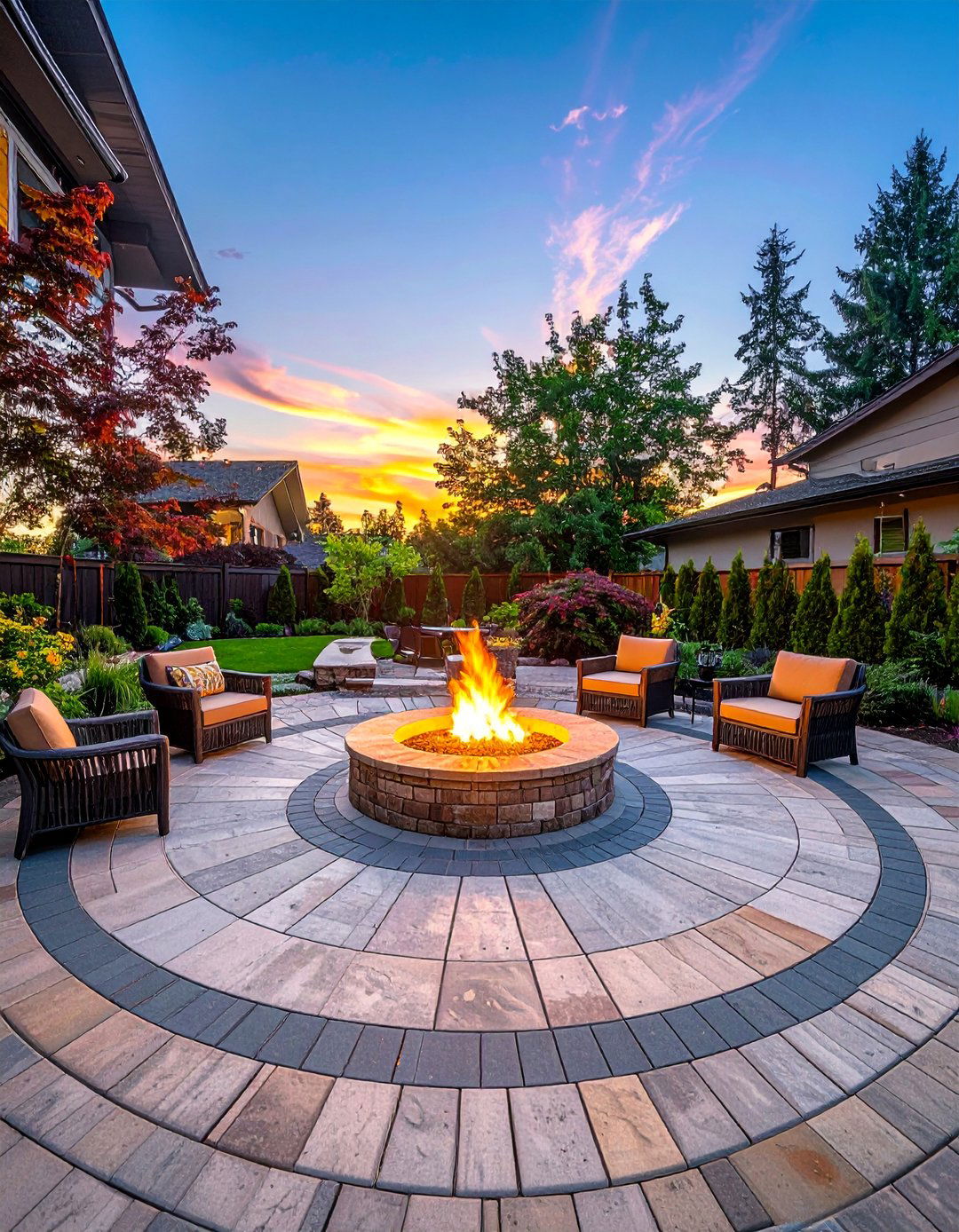
What makes circular outdoor spaces feel so inviting for gatherings? Circular patio hardscaping creates intimate conversation areas that naturally encourage social interaction and relaxation. This geometric design approach uses curved paving materials like brick, stone, or concrete arranged in radiating or concentric patterns that draw the eye inward toward central features. Fire pits, fountains, or planted urns work perfectly as focal points in circular designs. Surrounding landscape beds with curved edges complement the patio shape while providing planting opportunities for seasonal color and texture. Built-in seating along the perimeter maximizes gathering space while maintaining the circular flow. This timeless hardscaping solution works with various architectural styles, creating outdoor rooms that feel complete and purposeful while providing versatile spaces for intimate gatherings or larger entertainment events that benefit from the inclusive nature of circular designs.
22. Tiered Fountain Features
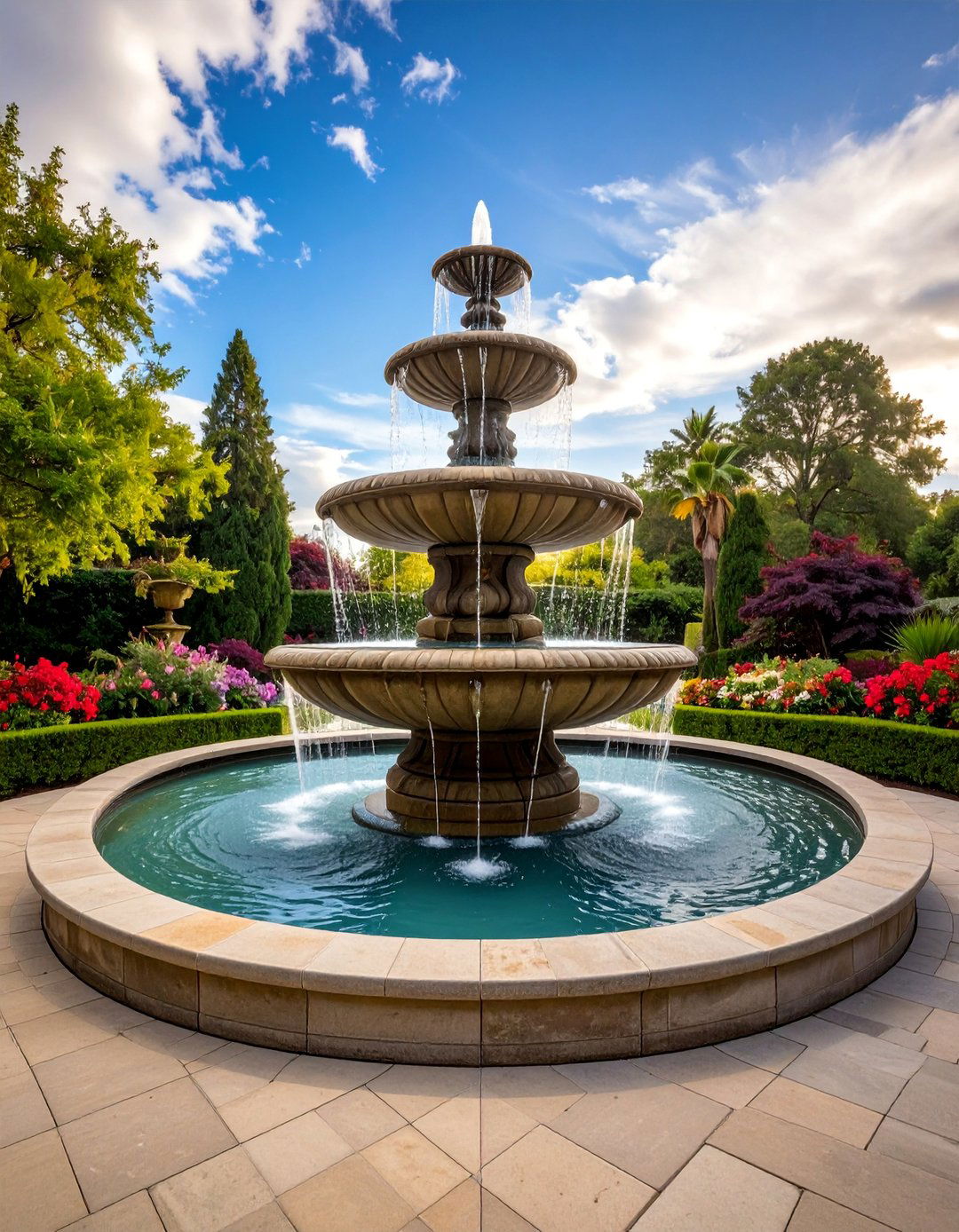
How can water features become dramatic landscape centerpieces? Tiered fountain hardscaping creates vertical water displays that provide visual and auditory focal points for outdoor spaces. This classical design approach uses multiple levels of stone, concrete, or metal basins that allow water to cascade from upper to lower tiers. The surrounding hardscape includes appropriate paving materials that can handle water splashing while providing stable surfaces for viewing and maintenance access. Planted areas around fountains benefit from increased humidity while adding lush greenery that complements the water feature. Underwater and landscape lighting create dramatic evening effects while extending enjoyment into nighttime hours. This sophisticated hardscaping element works particularly well in formal gardens or entry areas, creating impressive focal points that add significant aesthetic value while providing the relaxing sounds of moving water.
23. Decomposed Granite Surfaces
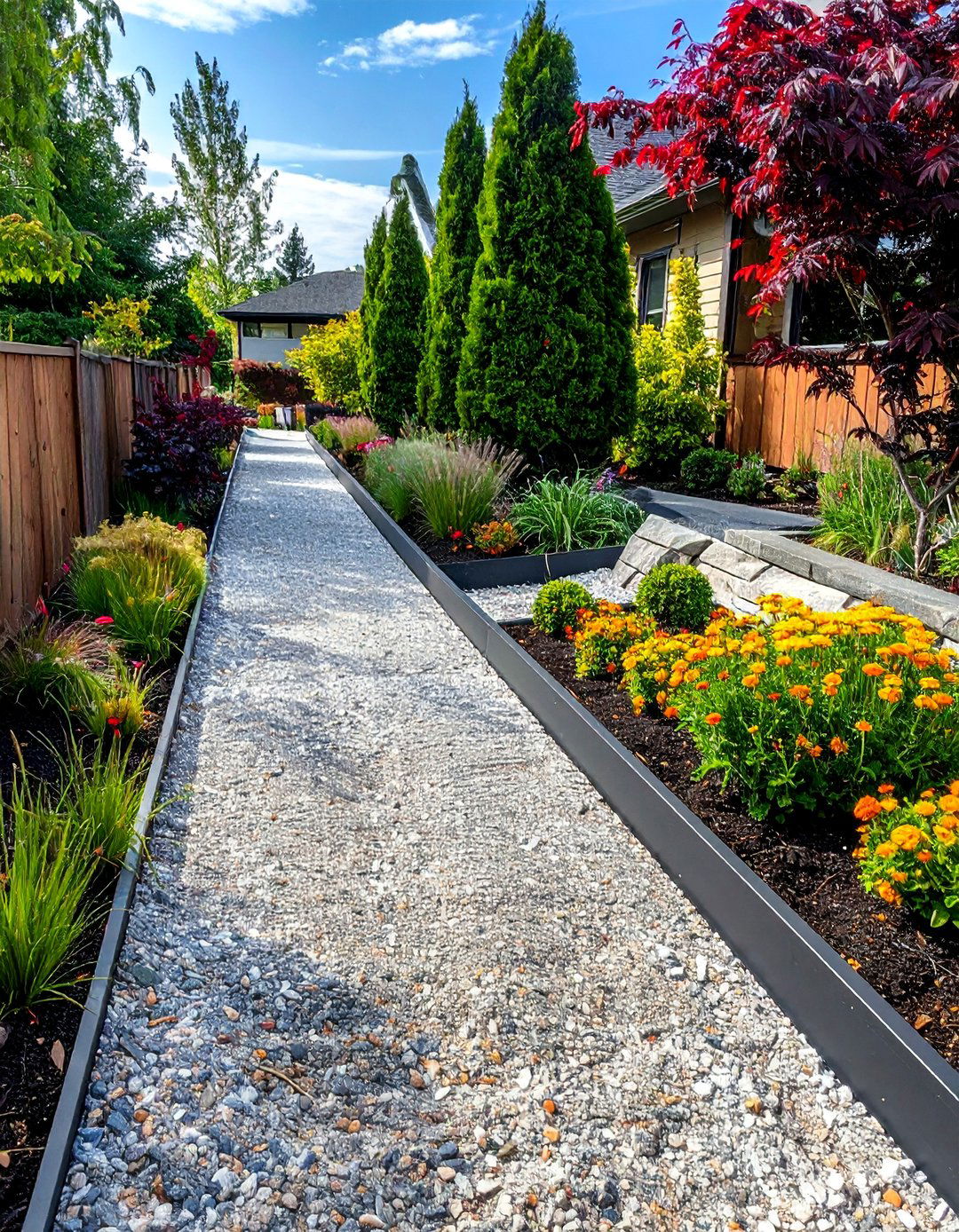
What makes decomposed granite such a popular hardscaping choice? Decomposed granite provides natural-looking surfaces that bridge the gap between hard paving and soft landscaping. This organic material compacts into stable surfaces for pathways, patios, and play areas while maintaining permeability and natural appearance. The fine texture and earth-tone colors complement both contemporary and traditional landscape designs. Stabilizing additives help maintain surface integrity while controlling dust and erosion. Border materials like steel edging or stone contain the granite while creating clean lines between different landscape zones. Surrounding plantings of drought-tolerant species work particularly well with decomposed granite, creating cohesive designs that feel naturally integrated. This versatile hardscaping material offers cost-effective solutions for large areas while providing accessible surfaces that work well for both pedestrian traffic and recreational activities in residential outdoor spaces.
24. Outdoor Fireplace Installations
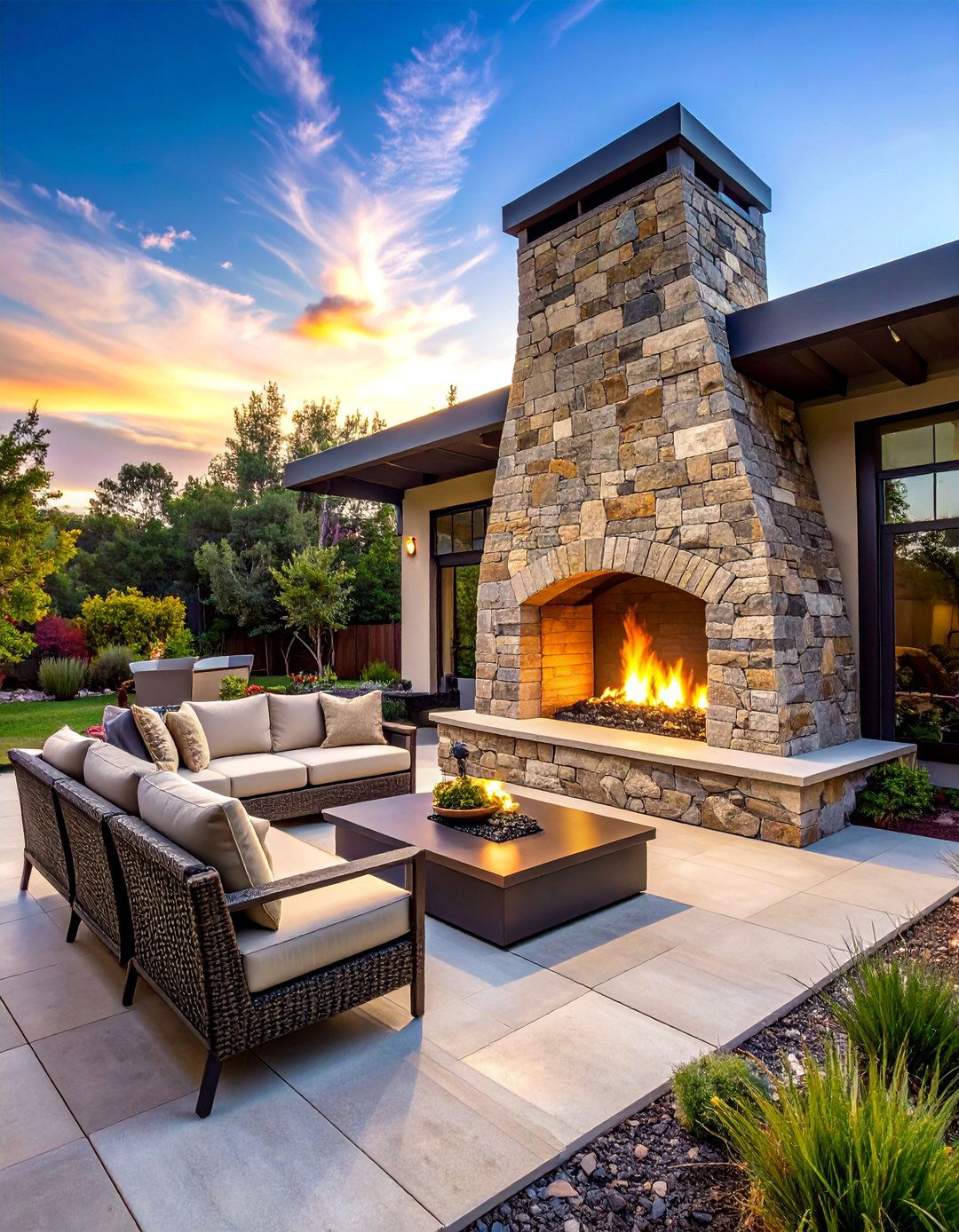
What creates the ultimate focal point for outdoor entertainment? Outdoor fireplace hardscaping combines architectural drama with functional heating for year-round outdoor living. This substantial design element uses stone, brick, or concrete construction to create permanent structures that serve as room dividers and gathering magnets. The fireplace design includes proper ventilation, safety clearances, and weather protection while complementing your home's architectural style. Surrounding seating areas on heat-resistant paving materials maximize the warming effect while creating intimate conversation spaces. Integrated storage for firewood and accessories maintains convenience while preserving the clean aesthetic. Landscape lighting highlights the fireplace structure while providing ambient illumination for evening gatherings. This premium hardscaping investment creates resort-quality outdoor living spaces that extend seasonal use while adding significant property value and creating memorable entertainment venues for family and friends.
25. Gabion Wall Construction
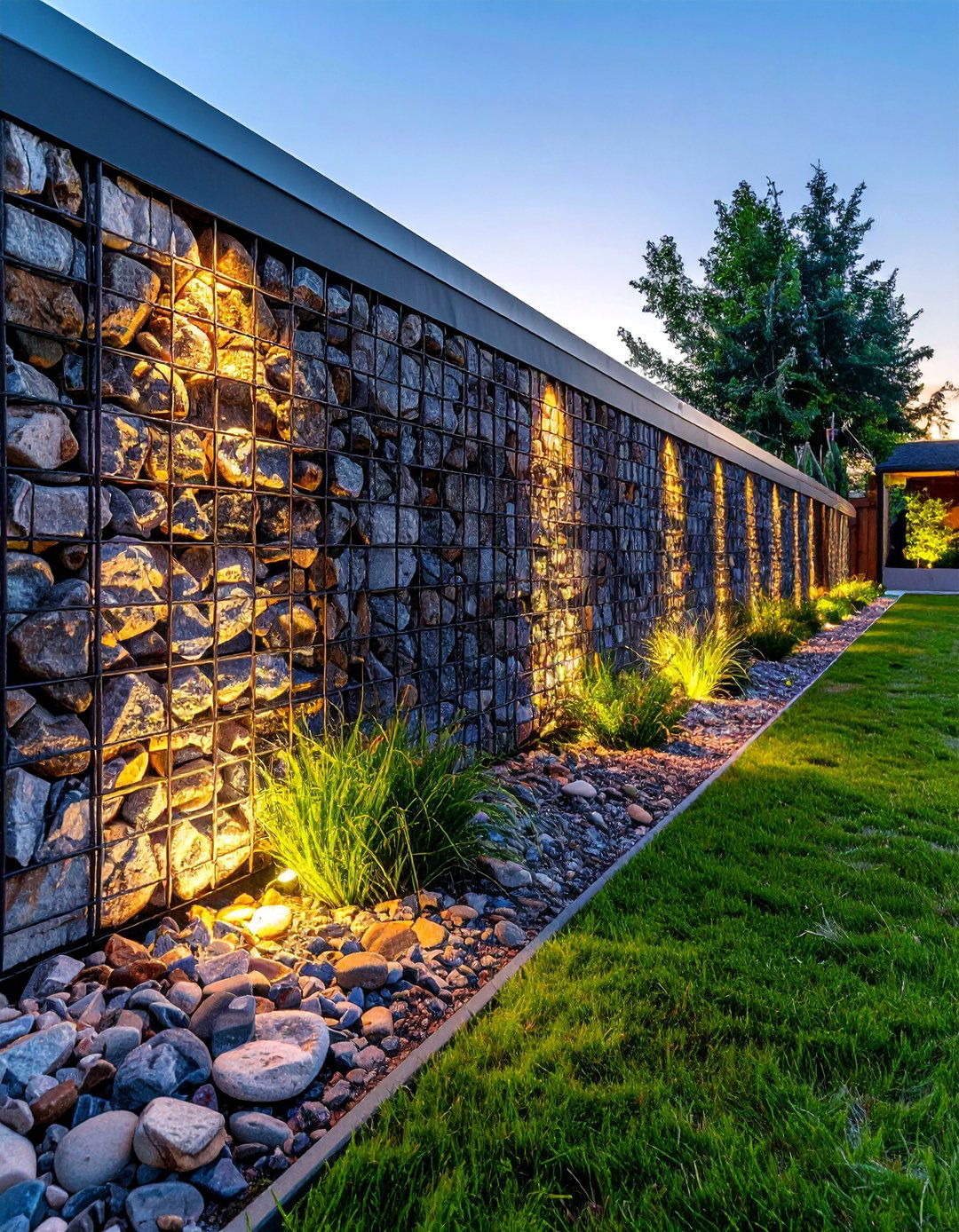
How can industrial materials create beautiful landscape features? Gabion wall hardscaping uses wire mesh containers filled with stone to create contemporary retaining and decorative walls. This modern approach combines structural engineering with artistic stone selection to create walls that provide excellent drainage while maintaining visual interest. The stone fill can include uniform river rock for clean appearances or mixed stones for more textural variety. Integrated planters and lighting can be incorporated into gabion designs for added functionality and beauty. The modular construction allows for curved walls and creative shapes that follow landscape contours. Surrounding hardscape elements like concrete pathways or steel edging complement the industrial aesthetic. This innovative hardscaping solution works particularly well with contemporary homes, creating striking landscape features that solve practical problems while making bold design statements that stand out from traditional wall construction methods.
26. Bocce Ball Court Design
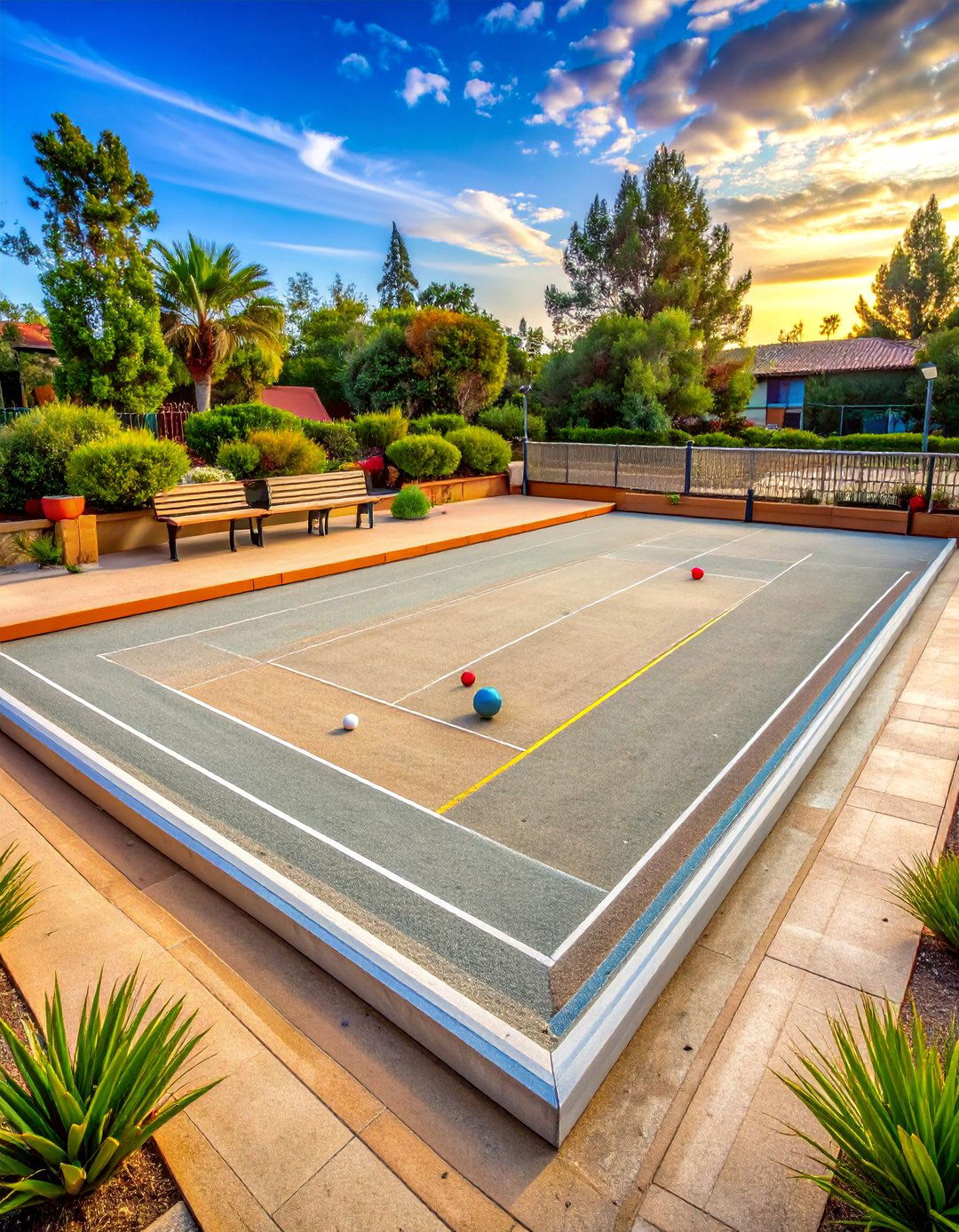
What outdoor activity combines recreation with beautiful hardscaping? Bocce ball court construction creates dedicated recreation areas using specific materials and dimensions for optimal gameplay. This recreational hardscaping project requires level surfaces using decomposed granite, artificial turf, or specialized court materials contained within sturdy borders. The regulation court size provides ample space for competitive play while serving as an attractive landscape feature when not in use. Surrounding hardscape includes spectator seating, storage for equipment, and appropriate lighting for evening games. Border materials like timber, concrete, or stone define the playing area while integrating with overall landscape design. Drainage systems ensure year-round playability while maintaining surface integrity. This active hardscaping element appeals to families and entertainers who enjoy outdoor games, creating focal points that encourage physical activity while adding unique recreational value to residential properties.
27. Stairway Landscaping
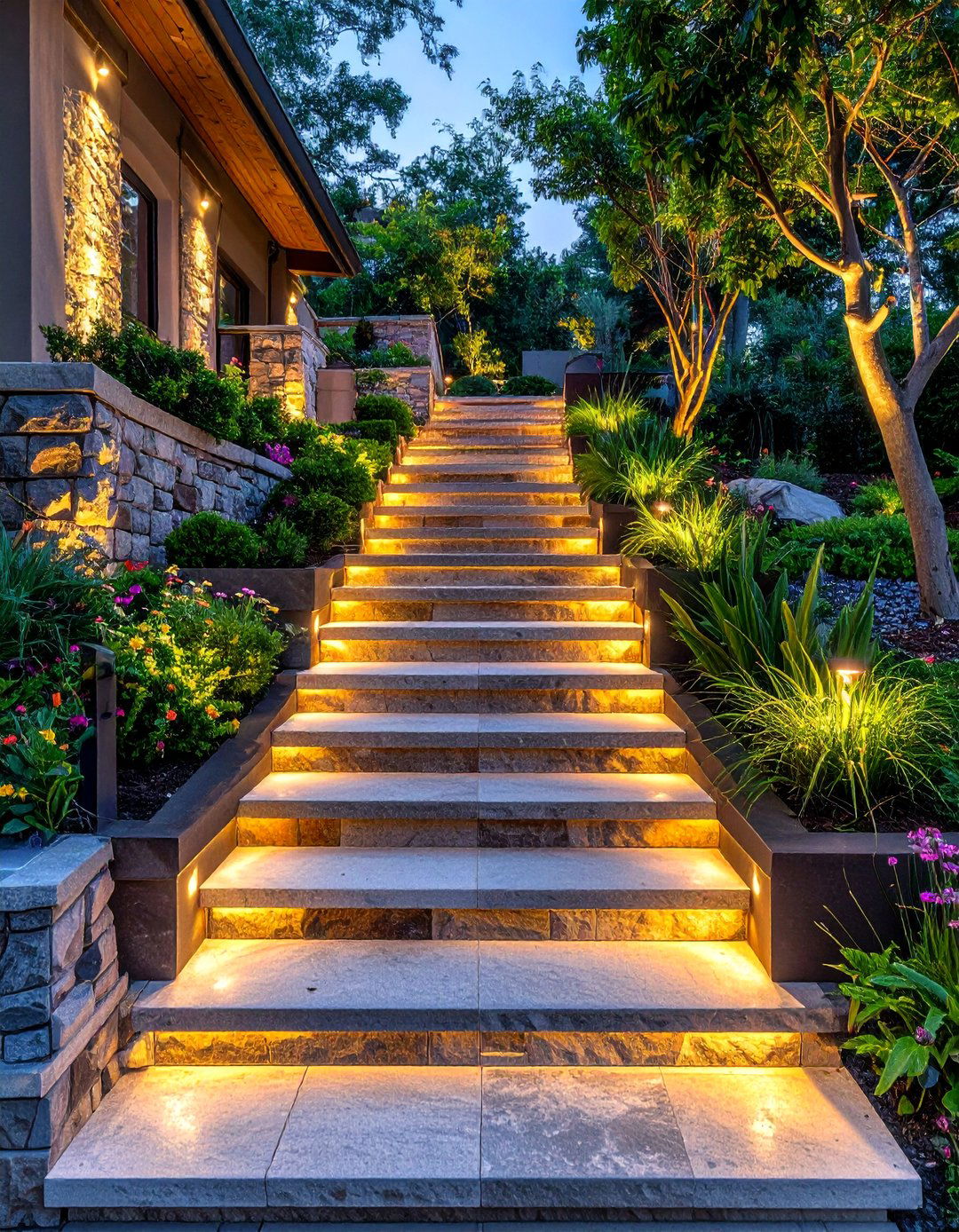
How can outdoor stairs become beautiful landscape transitions? Stairway hardscaping transforms elevation changes into attractive design opportunities using materials that complement surrounding landscape elements. This functional design approach uses stone, concrete, or timber to create safe passage between different yard levels while adding architectural interest. Built-in planters along stair edges soften hard surfaces while providing seasonal color and texture opportunities. Integrated lighting in steps or handrails improves safety while creating dramatic evening effects. Proper drainage prevents water accumulation while maintaining surface traction during wet conditions. The stair design should complement existing hardscape materials while providing comfortable rise and run dimensions for safe navigation. This essential hardscaping element works with any architectural style, creating functional connections between yard levels while adding significant aesthetic value that transforms necessary infrastructure into attractive landscape features.
28. Artificial Turf Integration
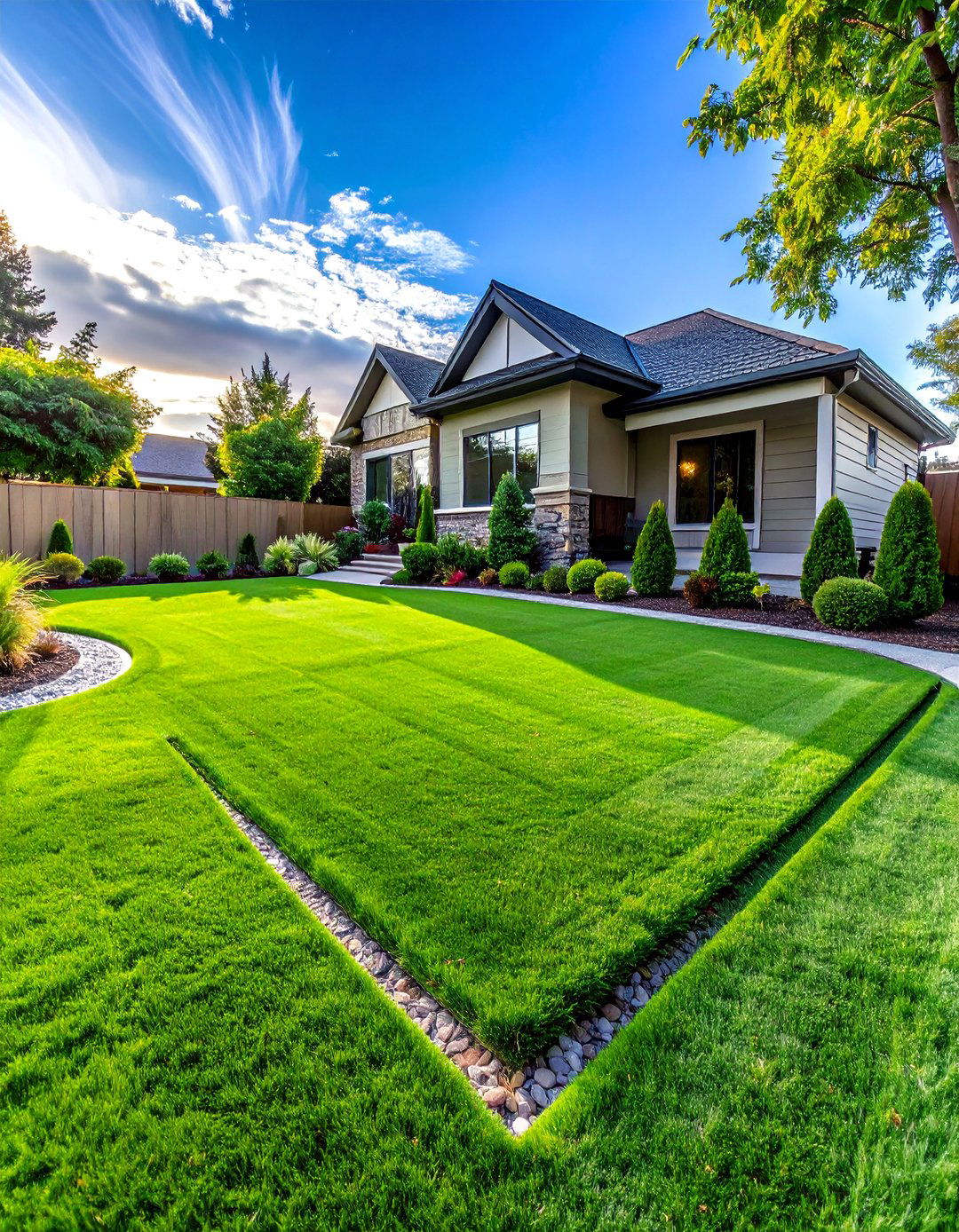
What hardscaping complement synthetic grass installations? Artificial turf integration uses border materials and surface transitions to create seamless connections between synthetic and natural landscape elements. This low-maintenance approach combines realistic grass alternatives with appropriate edging materials like concrete, stone, or steel that create clean transitions to planted areas and hardscape features. The synthetic surface provides year-round green color while requiring no irrigation, fertilization, or mowing. Surrounding hardscape elements like pathways, patios, and planters create functional zones while maintaining aesthetic cohesion. Proper drainage systems beneath artificial turf prevent water accumulation while extending surface life. This water-wise hardscaping solution works particularly well in drought-prone regions, creating beautiful outdoor spaces that require minimal maintenance while providing safe, clean surfaces for recreation and relaxation that maintain consistent appearance regardless of weather conditions.
29. Zen Garden Elements
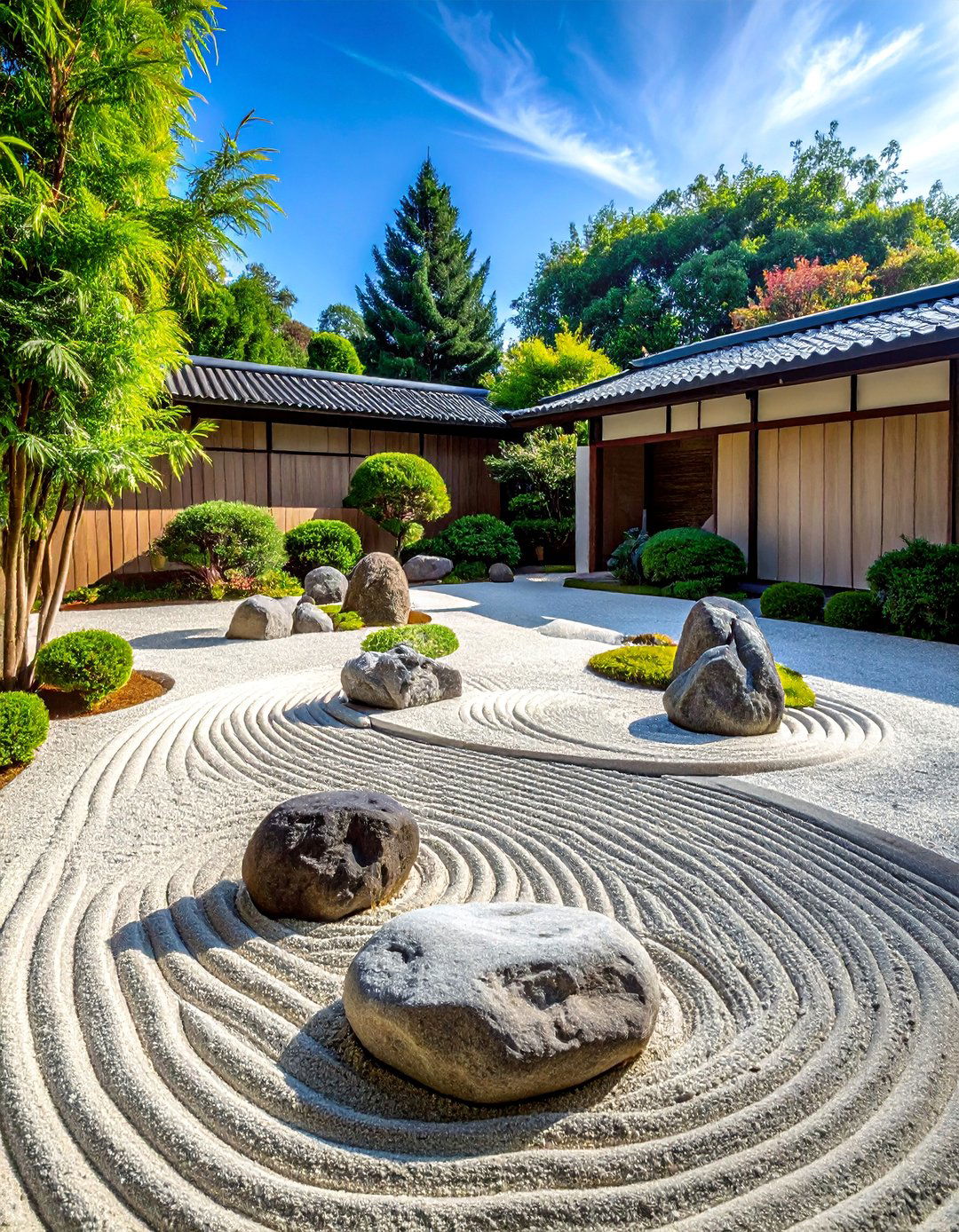
How can hardscaping create peaceful meditation spaces? Zen garden hardscaping combines minimalist design principles with natural materials to create contemplative outdoor areas. This spiritual approach uses raked gravel, carefully placed stones, and simple plantings to create spaces that encourage reflection and stress reduction. The hardscape elements include stone benches for meditation, gravel surfaces that can be raked into patterns, and strategically placed boulders that serve as focal points. Bamboo screens or simple fencing provide privacy while maintaining connection to nature. Water features like small fountains add soothing sounds while avoiding complexity that might distract from meditation purposes. This therapeutic hardscaping theme works well in small spaces, creating peaceful retreats that provide mental health benefits while adding unique aesthetic value to residential landscapes through careful attention to balance, proportion, and natural material selection.
30. Playground Safety Surfaces
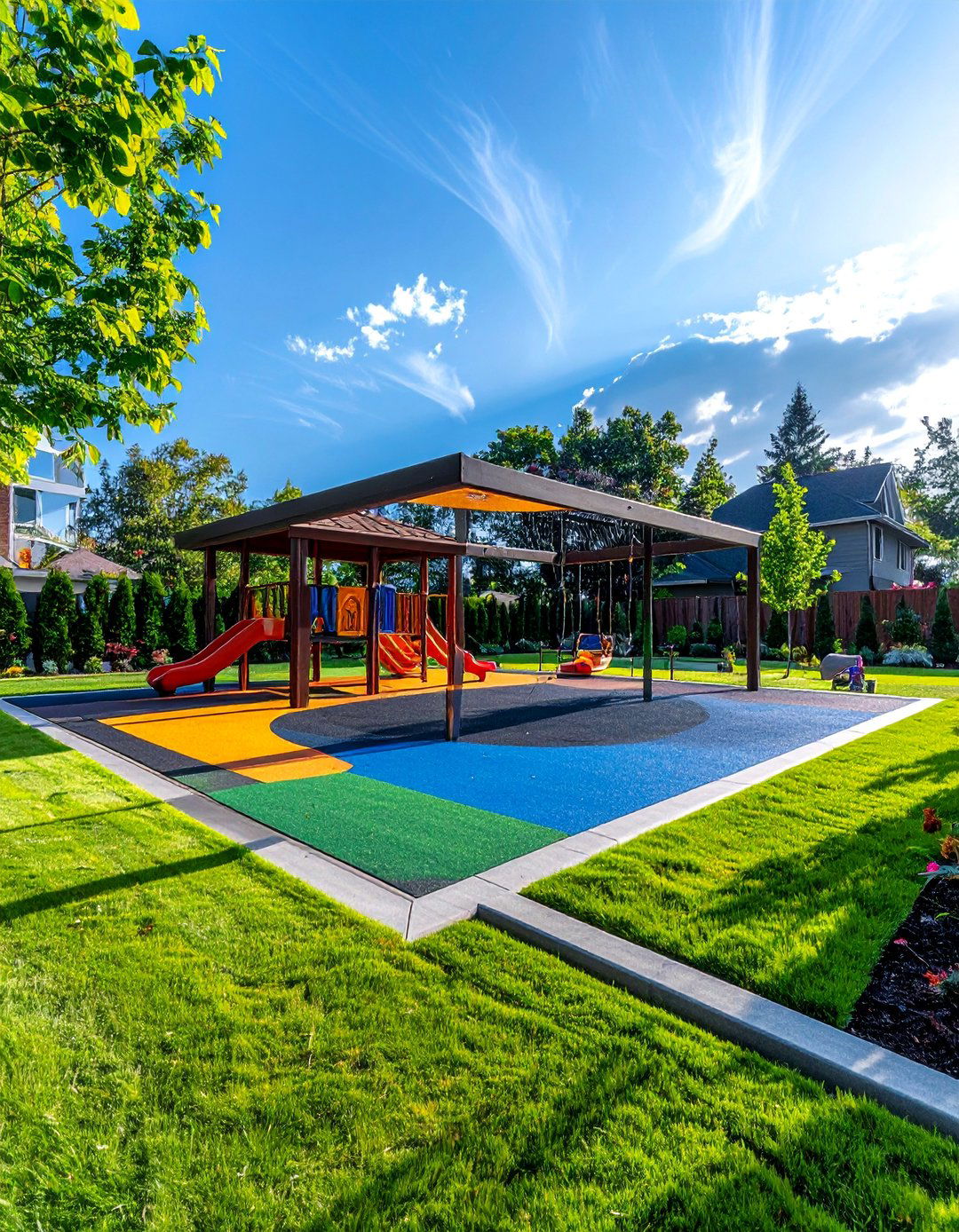
What hardscaping materials create safe children's play areas? Playground surface hardscaping uses specialized materials that provide impact protection while maintaining drainage and accessibility. This safety-focused design approach combines rubberized surfaces, engineered wood fiber, or poured-in-place materials that meet safety standards for fall protection. The surrounding hardscape includes borders that contain play surface materials while creating clear boundaries between play and landscape areas. Integrated seating for supervision and shade structures for sun protection enhance functionality while maintaining safety focus. Proper drainage prevents surface flooding while maintaining material integrity during wet conditions. This family-oriented hardscaping solution creates dedicated play spaces that give parents peace of mind while providing children with safe surfaces for active recreation that complement overall landscape design while meeting specific safety requirements for residential playground installations.
31. Succulent Rock Gardens
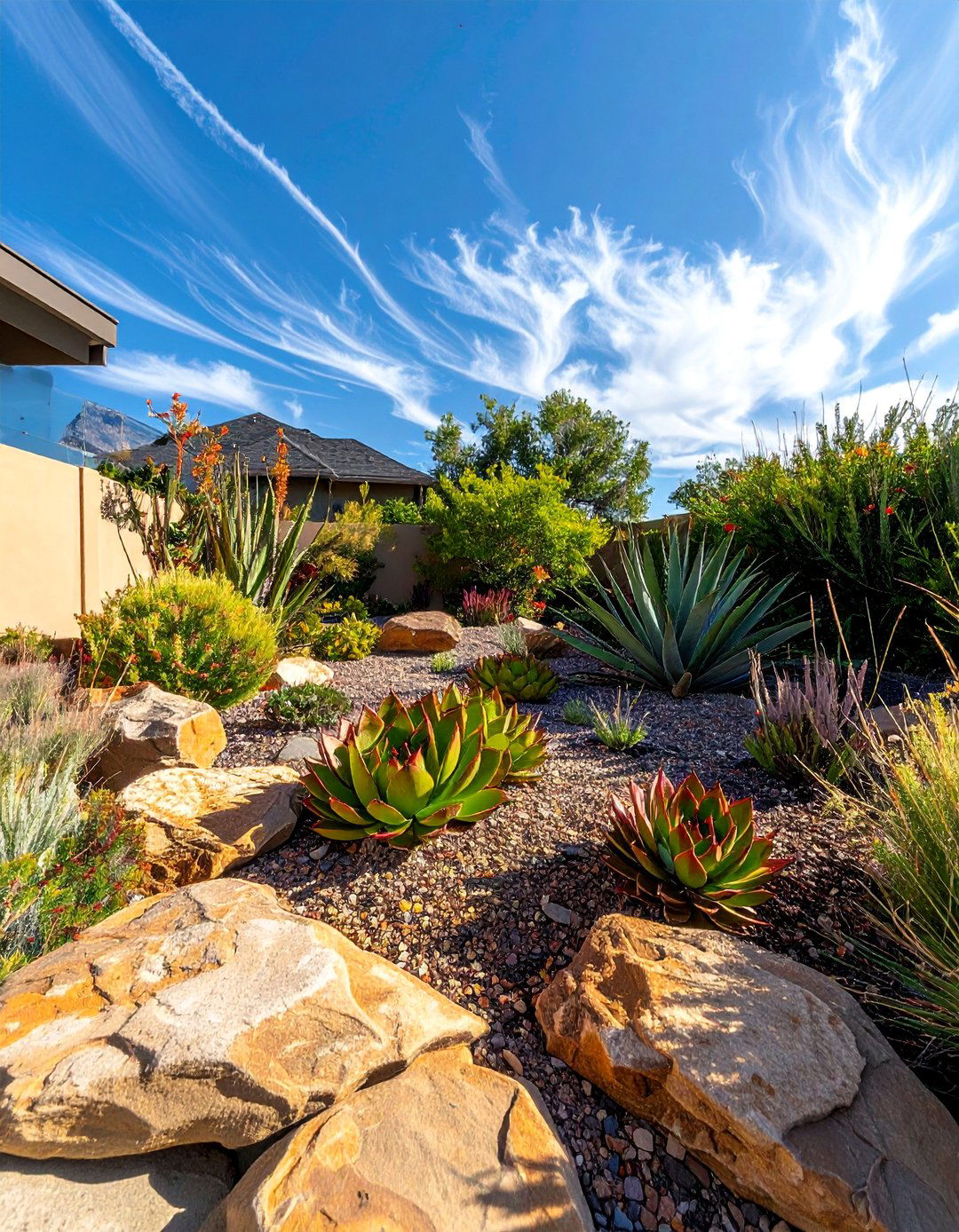
How can drought-tolerant plants integrate with hardscaping? Succulent rock garden design combines water-wise plants with stone hardscaping to create stunning low-maintenance landscapes. This desert-inspired approach uses decorative rocks, boulders, and gravel as both growing medium and design elements that complement succulent plant forms and colors. The hardscape provides excellent drainage while creating microclimates that protect plants from extreme weather. Pathways of flagstone or decomposed granite allow access for maintenance while adding structural elements to the design. Rock mulches suppress weeds while conserving soil moisture and creating attractive surface textures. This sustainable hardscaping theme works exceptionally well in arid climates, creating beautiful garden areas that require minimal water and maintenance while providing year-round color and interest through careful selection of both hardscape materials and plant varieties that thrive in challenging conditions.
32. Outdoor Bar Areas
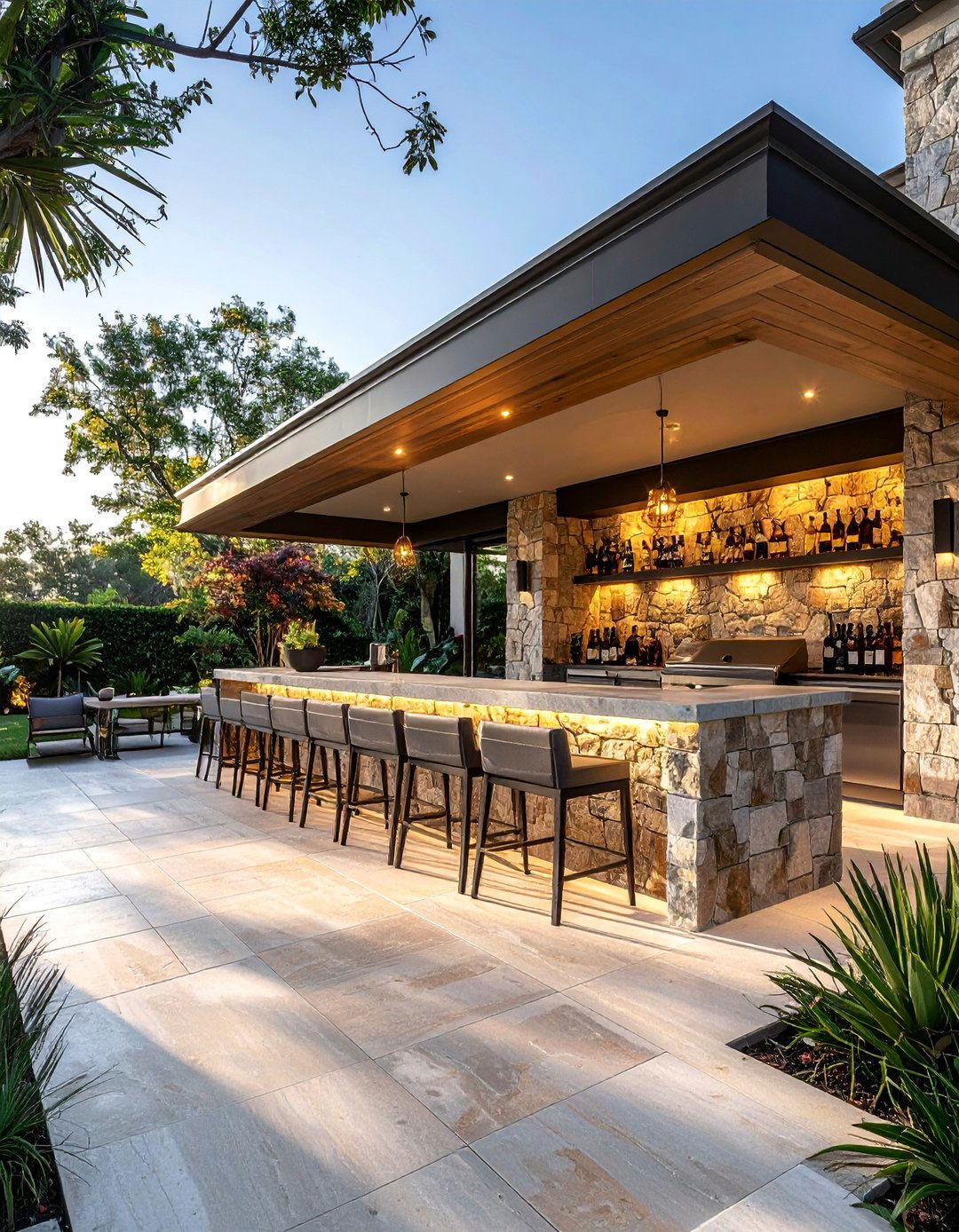
What hardscaping creates perfect outdoor entertaining zones? Outdoor bar area construction combines serving surfaces with storage and seating to create social focal points for gatherings. This entertainment-focused design uses weather-resistant materials like stone, concrete, or marine-grade finishes to create functional bar tops with integrated storage for supplies and equipment. The surrounding hardscape includes appropriate flooring that can handle spills while providing stable surfaces for bar stools and gathering areas. Built-in refrigeration and plumbing connections enhance functionality while maintaining clean aesthetic lines. Overhead structures provide weather protection while housing lighting and electrical systems. This sophisticated hardscaping investment creates resort-quality entertainment areas that enhance property value while providing dedicated spaces for social activities that encourage outdoor living and entertainment throughout multiple seasons, making every gathering feel like a special occasion.
33. Gravel Driveways
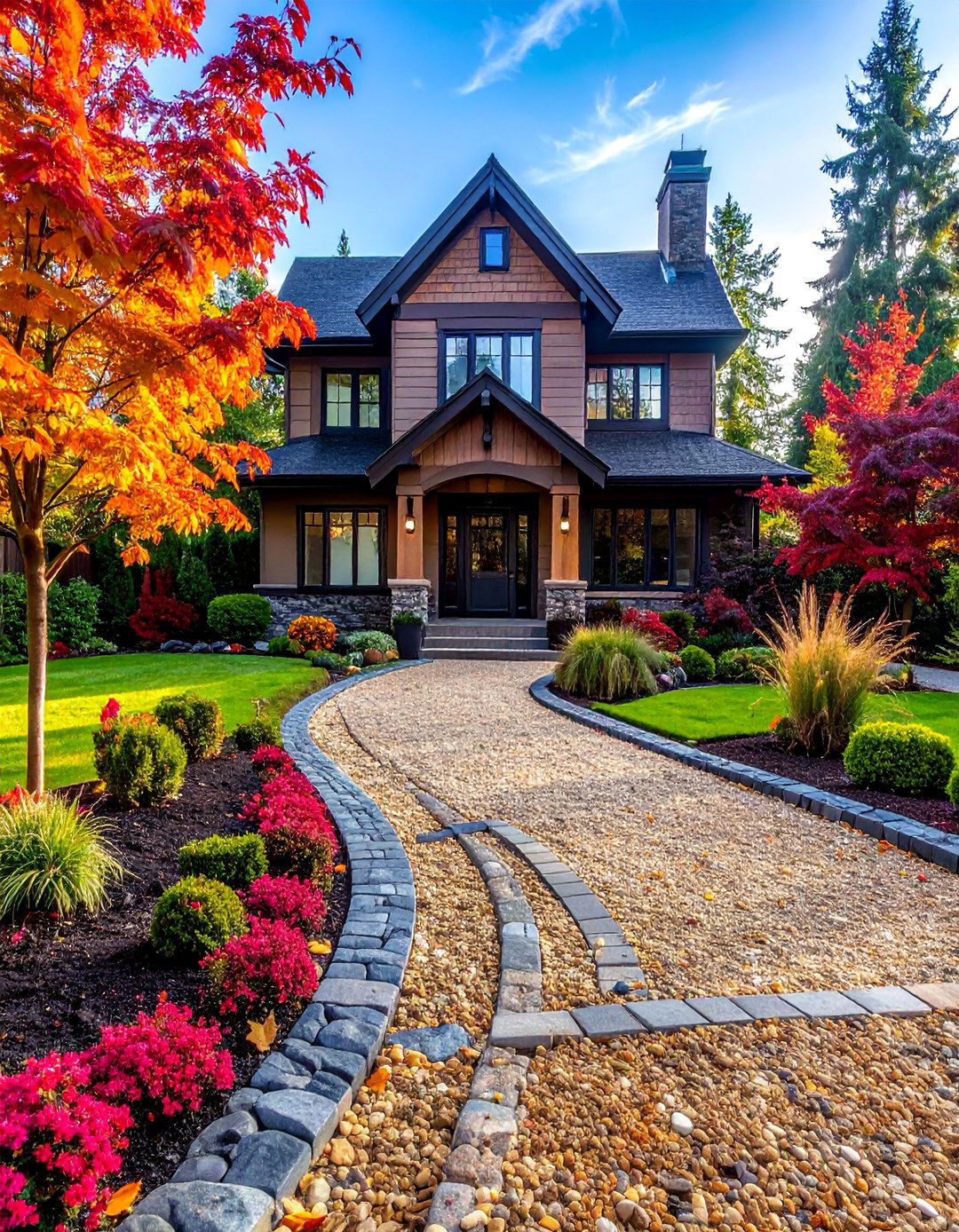
How can utilitarian driveways become attractive landscape features? Gravel driveway hardscaping uses decorative aggregate materials to create permeable surfaces that complement overall landscape design. This cost-effective approach combines functionality with aesthetic appeal using various stone sizes and colors that coordinate with home architecture and surrounding hardscape elements. Proper edge restraints contain gravel while creating clean lines between driveway and planted areas. Drainage systems prevent washout while maintaining surface integrity during heavy rainfall. The permeable surface reduces runoff while providing practical vehicle access that requires less maintenance than traditional paved surfaces. This versatile hardscaping solution works with various architectural styles, creating attractive approaches to homes while solving practical access needs with materials that blend naturally into landscape settings while requiring periodic maintenance that homeowners can typically manage themselves.
34. Mosaic Paving Accents
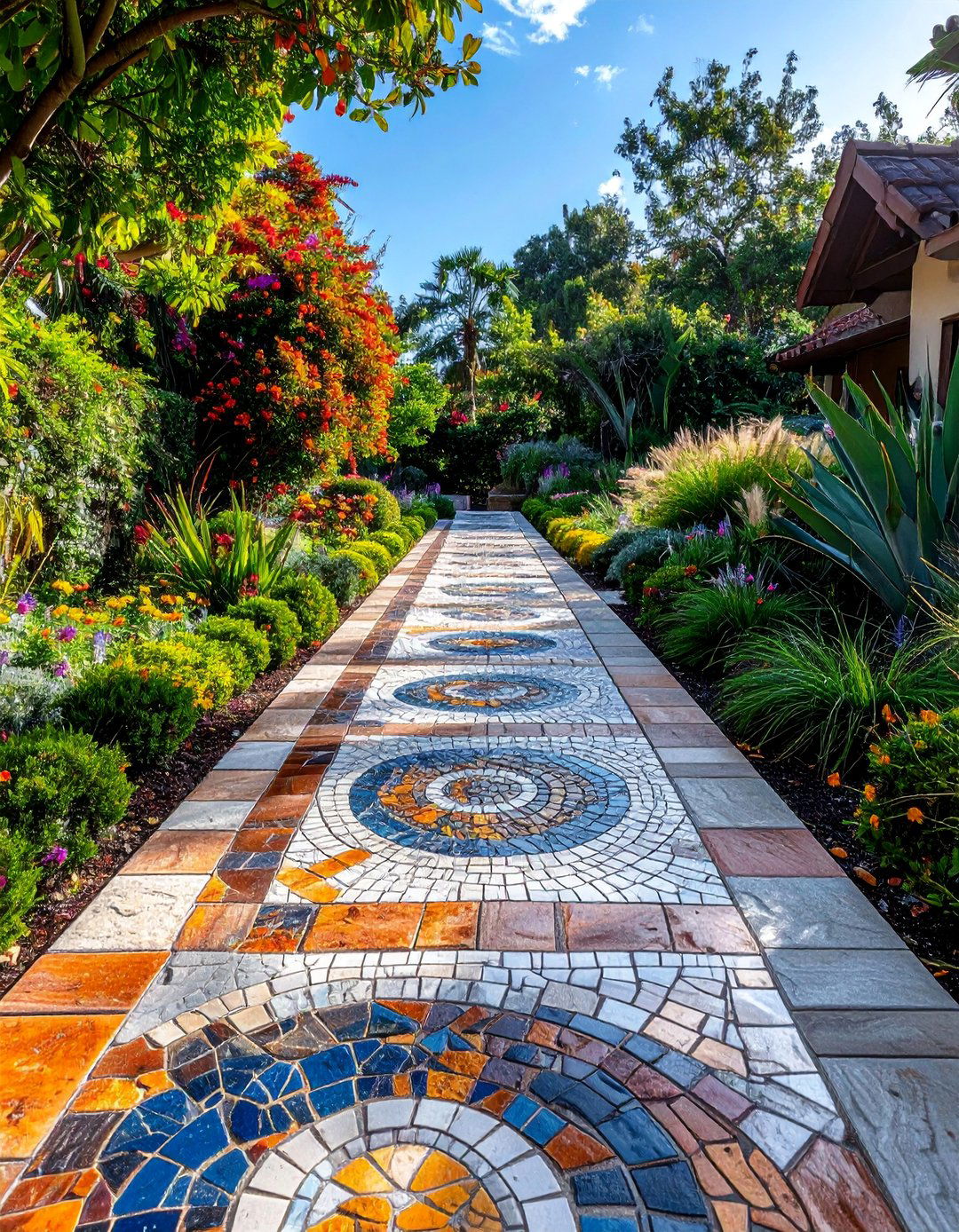
What can transform ordinary paving into artistic statements? Mosaic paving hardscaping incorporates decorative tile, stone, or glass elements into larger paved surfaces to create custom artistic features. This creative approach uses small pieces arranged in patterns or pictures that add personal expression and visual interest to patios, walkways, or entry areas. The mosaic elements can highlight borders, create central medallions, or form flowing patterns that guide movement through outdoor spaces. Proper installation techniques ensure long-term durability while maintaining slip resistance for safety. Surrounding hardscape materials should complement mosaic colors and styles while providing appropriate transitions to planted areas. This artistic hardscaping technique works particularly well in Mediterranean or contemporary designs, creating unique outdoor features that reflect personal style while adding significant aesthetic value through custom designs that cannot be replicated elsewhere.
35. Retractable Shade Systems
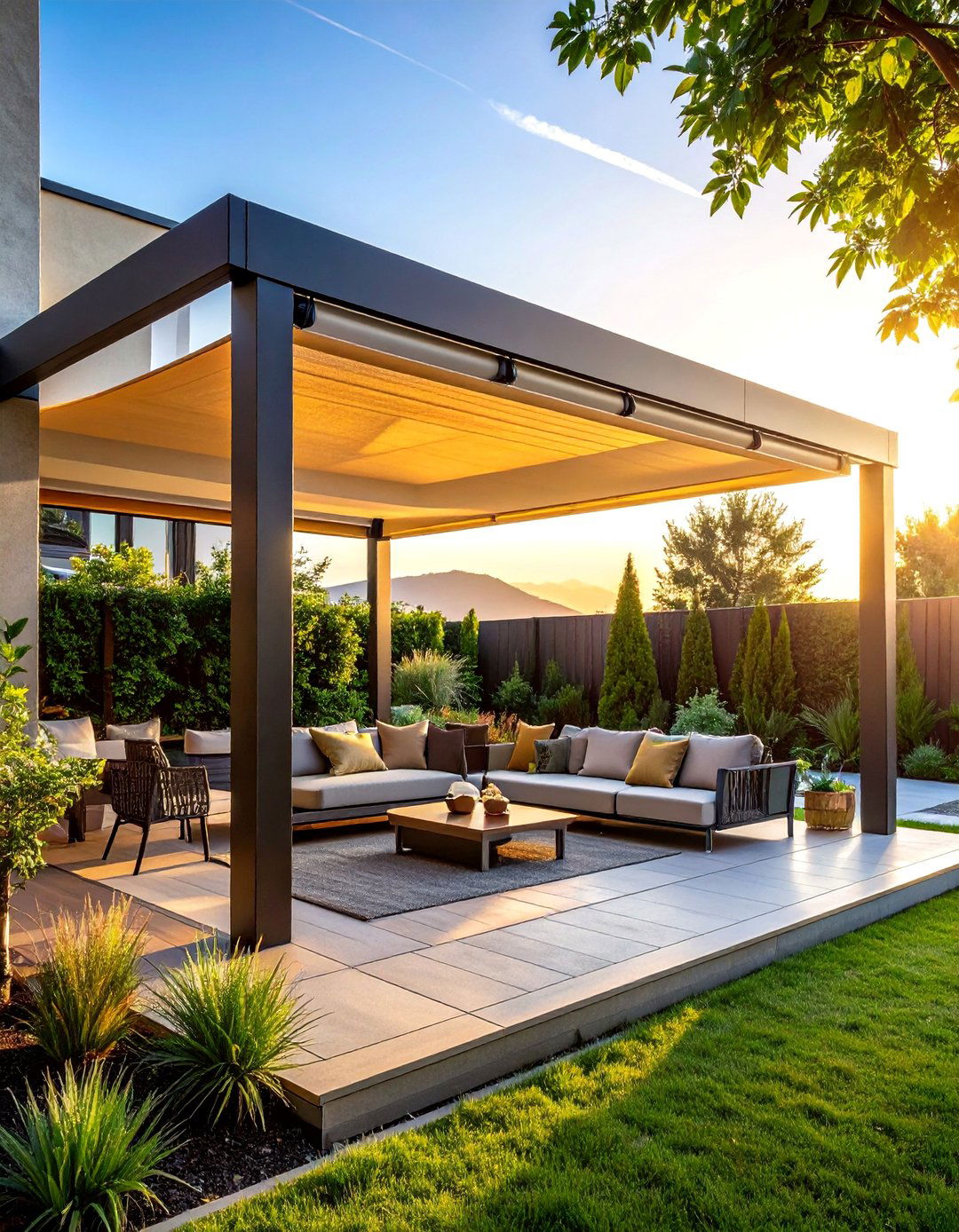
How can hardscaping accommodate changing sun protection needs? Retractable shade system integration combines permanent structures with adjustable elements to provide flexible outdoor comfort. This adaptive design approach uses sturdy posts and tracks anchored in concrete foundations to support fabric or rigid panels that extend and retract as needed. The hardscape beneath accommodates both shaded and unshaded conditions using materials that perform well in variable sun exposure. Built-in controls allow easy adjustment while weather sensors can provide automatic operation during wind or rain conditions. The structural elements complement architectural styles while providing practical sun protection that enhances outdoor living comfort. This advanced hardscaping solution works particularly well in regions with intense sun exposure, creating versatile outdoor spaces that adapt to changing conditions while maintaining aesthetic appeal and providing comfortable environments for relaxation and entertainment throughout the day.
36. Sculptural Water Walls
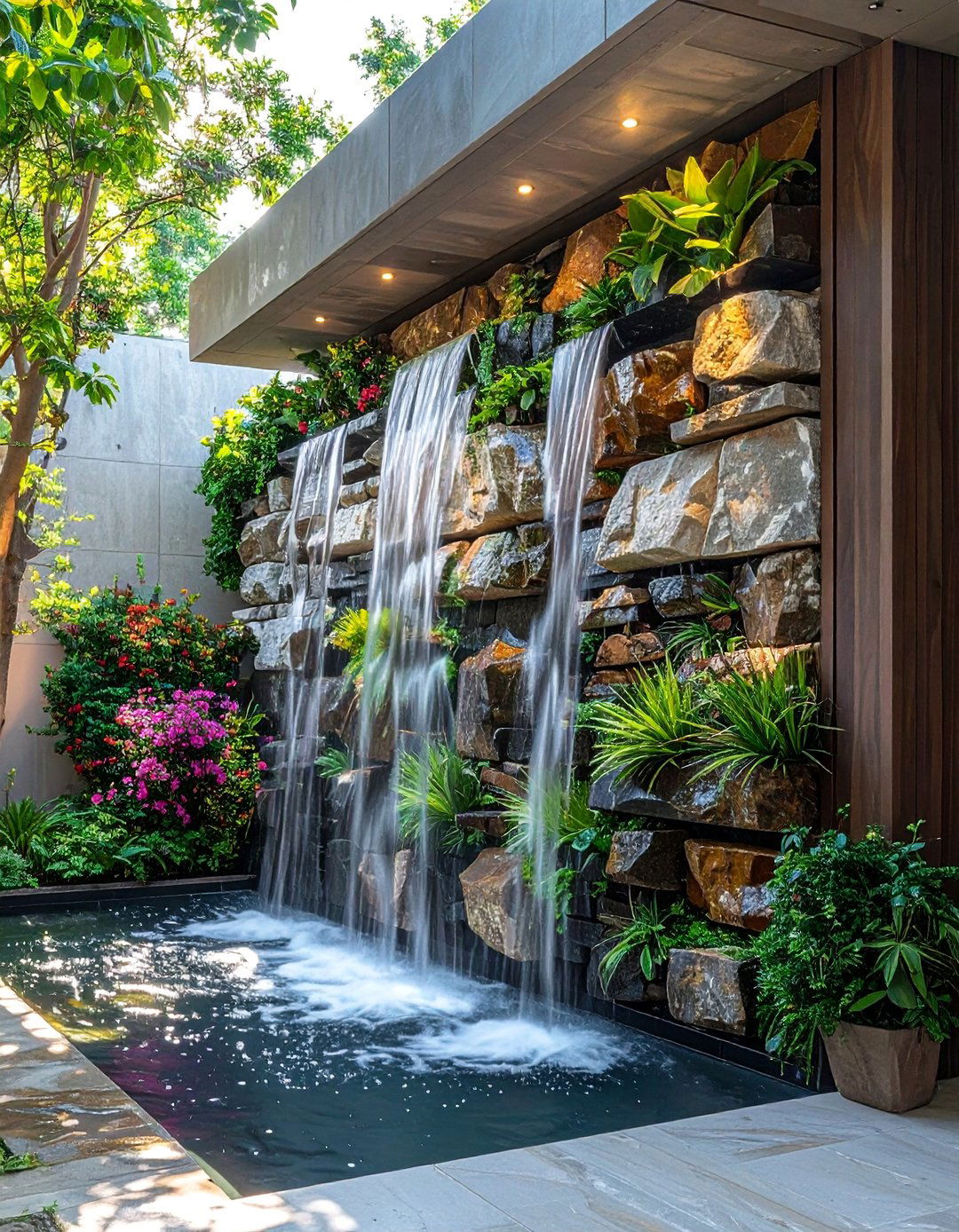
What creates dramatic vertical water features in modern landscapes? Sculptural water wall hardscaping combines contemporary art with functional water features to create striking focal points. This artistic approach uses materials like steel, stone, or concrete formed into geometric or organic shapes that support flowing water displays. The water wall structure requires proper pumping and filtration systems while creating visual and auditory interest that enhances outdoor environments. Surrounding hardscape provides appropriate viewing areas while managing water splash and drainage effectively. Integrated lighting creates spectacular evening effects while highlighting water movement and structural details. The modern aesthetic complements contemporary architecture while providing cooling effects and white noise benefits. This premium hardscaping investment creates unique outdoor features that serve as conversation pieces while adding significant aesthetic value through custom designs that integrate water, structure, and artistic expression in cohesive outdoor installations.
37. Butterfly Garden Hardscaping
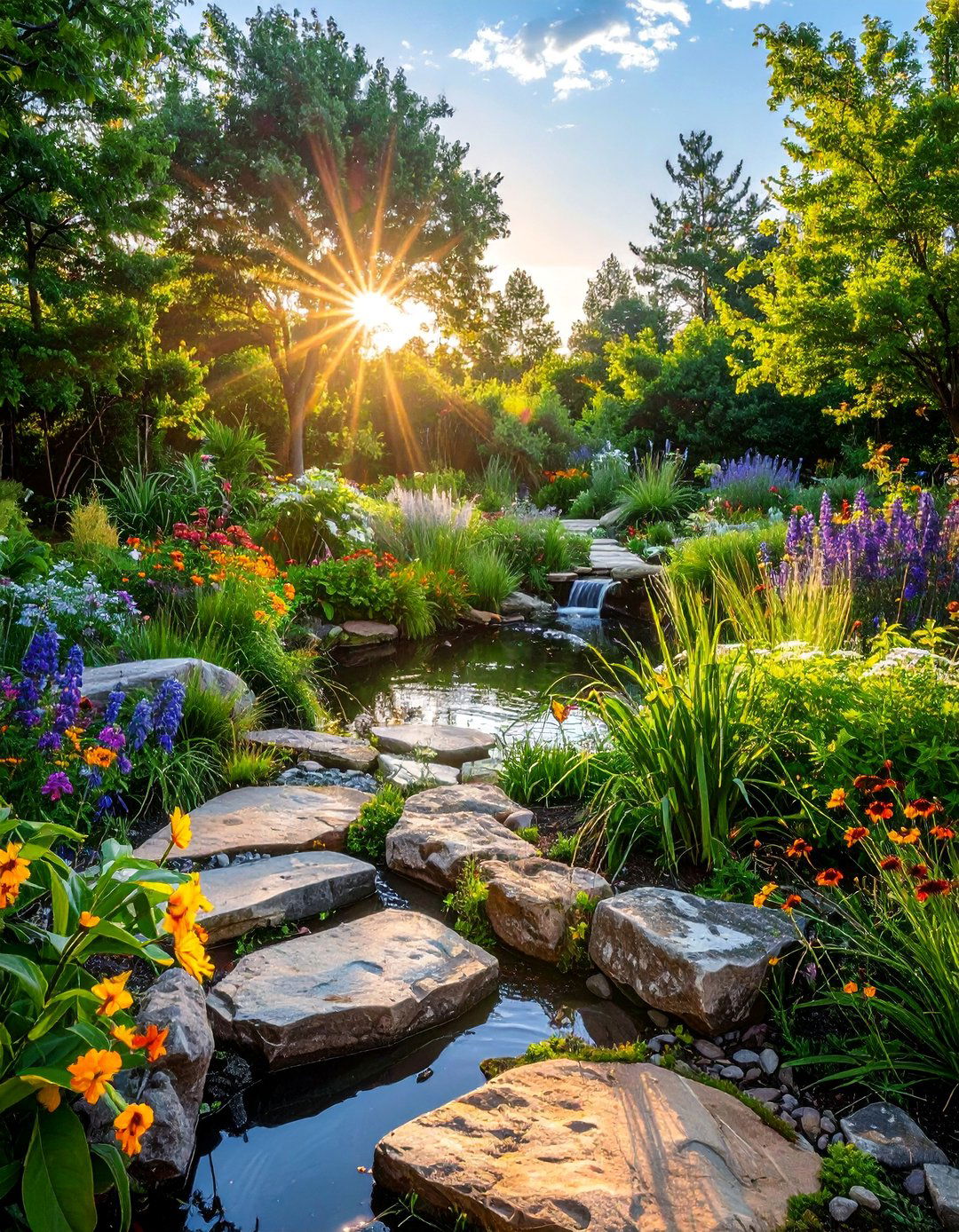
How can hardscaping support wildlife while creating beautiful gardens? Butterfly garden hardscaping combines habitat creation with aesthetic design to attract and support beneficial insects. This ecological approach uses natural stone pathways, seating areas, and water features that provide butterfly needs while creating enjoyable human spaces. The hardscape includes shallow water sources, sun-warmed stones for basking, and wind protection that creates favorable microclimates for butterfly activity. Plant selection focuses on native species that provide nectar and larval food sources while surrounding hardscape elements complement natural garden aesthetics. Maintenance access paths allow garden care while minimizing disturbance to wildlife habitat. This environmental hardscaping theme creates beautiful outdoor spaces that contribute to ecosystem health while providing educational opportunities for families interested in wildlife observation and habitat conservation that benefits both local environments and human enjoyment.
38. Vegetable Garden Infrastructure
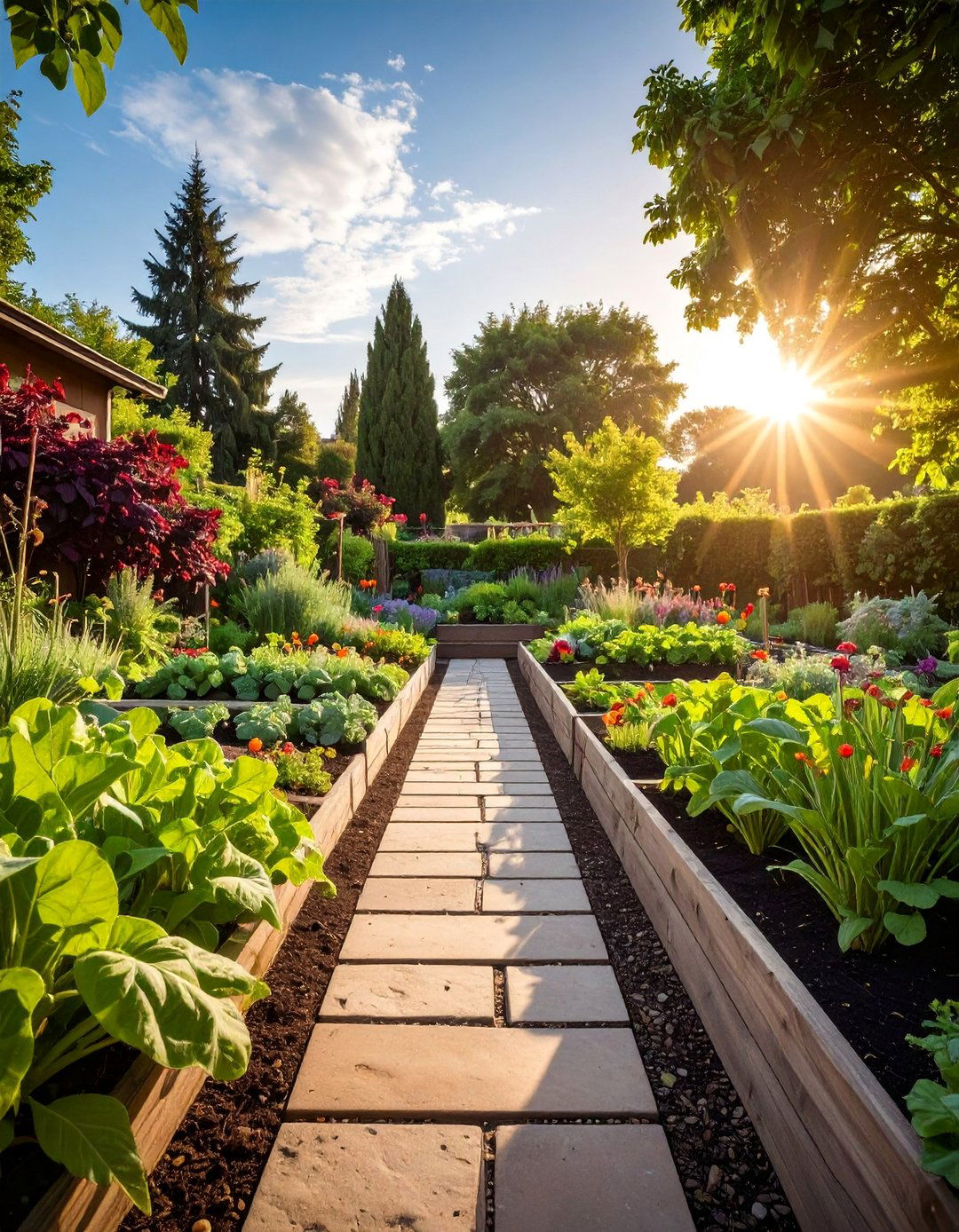
What hardscaping elements make vegetable gardens more productive and attractive? Vegetable garden hardscaping combines practical growing infrastructure with aesthetic design to create beautiful food production areas. This agricultural approach uses raised beds, irrigation systems, and pathways that facilitate maintenance while creating organized, attractive garden layouts. The hardscape includes materials like stone, concrete, or timber that contain growing areas while providing comfortable working heights that reduce physical strain. Tool storage, composting areas, and washing stations integrate into the overall design while maintaining functional efficiency. Trellises and support structures for climbing plants add vertical interest while maximizing growing space in limited areas. This productive hardscaping theme creates outdoor spaces that provide fresh food while adding aesthetic value through careful attention to materials and layout that make vegetable gardening more enjoyable and accessible for homeowners interested in sustainable food production.
39. Solar Lighting Integration
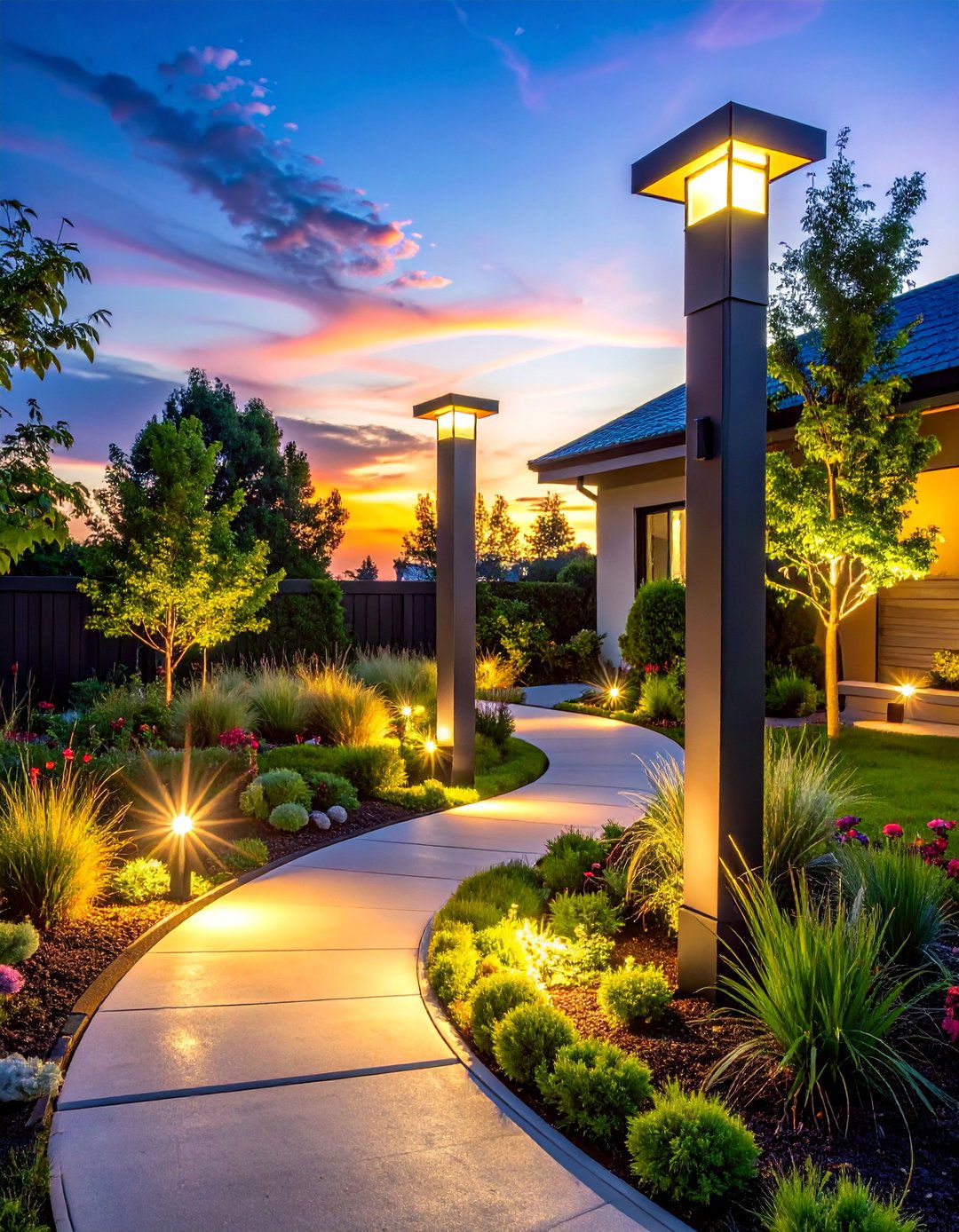
How can hardscaping incorporate sustainable illumination systems? Solar lighting hardscaping integrates renewable energy illumination with landscape design to create environmentally responsible outdoor lighting. This sustainable approach uses solar fixtures built into pathways, walls, and structures to provide evening illumination without electrical infrastructure. The hardscape design accommodates solar panel placement while maintaining aesthetic appeal during daylight hours. LED technology provides bright, efficient lighting while battery systems store energy for extended operation. The lighting design enhances safety and security while creating dramatic evening effects that highlight hardscape features and landscape elements. This eco-friendly hardscaping solution reduces energy costs while providing practical illumination that works independently of electrical systems, creating outdoor spaces that function effectively during evening hours while supporting environmental stewardship through renewable energy use that requires minimal maintenance and provides reliable operation.
40. Multi-Season Interest Design
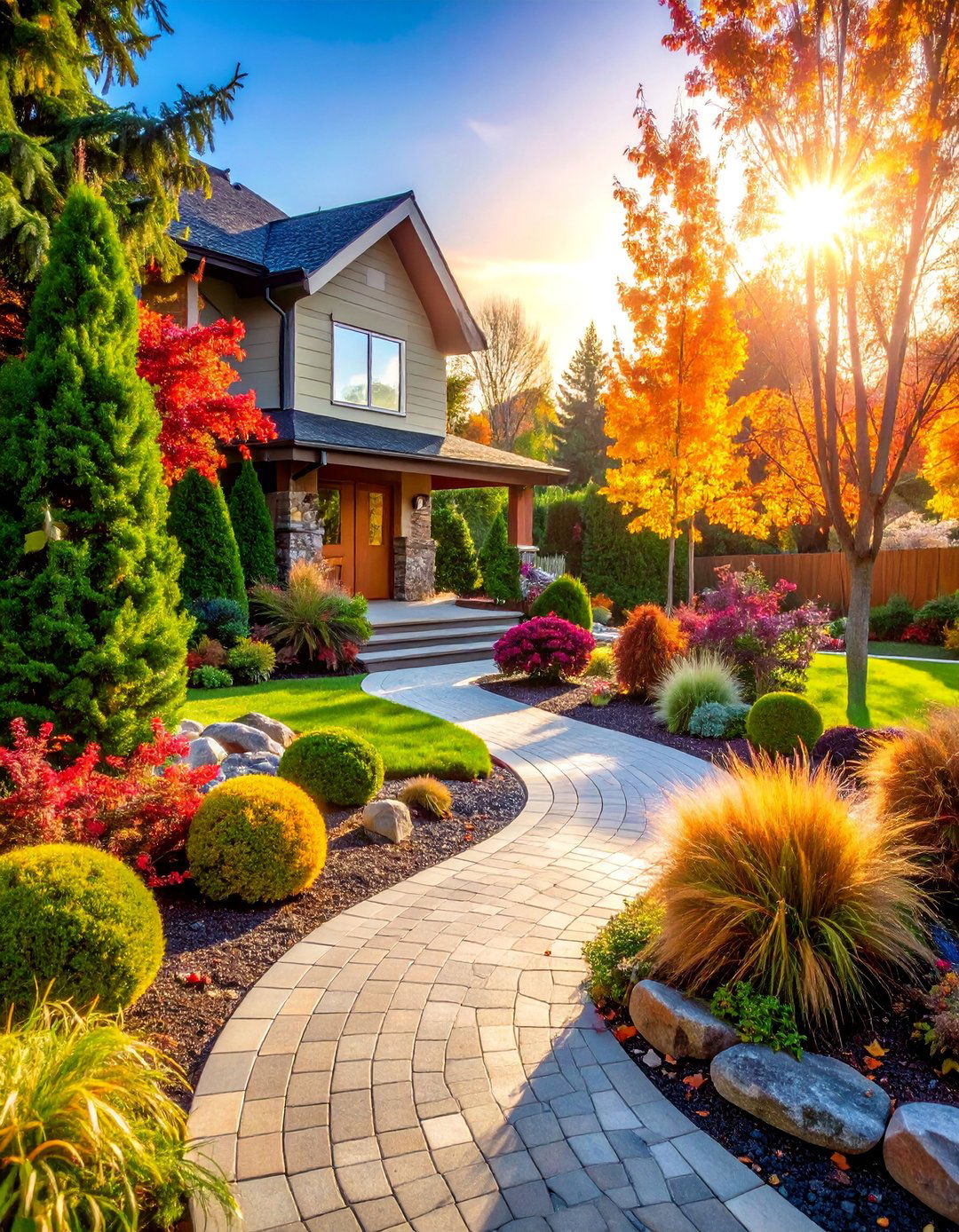
What hardscaping elements provide year-round beauty and functionality? Multi-season hardscaping design incorporates materials and features that remain attractive and useful throughout changing weather conditions. This comprehensive approach combines evergreen structural elements with seasonal adaptability to create outdoor spaces that provide value regardless of weather or time of year. The hardscape includes weather-resistant materials, drainage systems, and sheltered areas that function effectively during rain, snow, and extreme temperatures. Seasonal plant selection provides changing colors and textures while hardscape elements maintain consistent aesthetic appeal. Storage solutions accommodate seasonal furniture and equipment while maintaining clean design lines. This all-weather hardscaping approach creates outdoor investments that provide continuous value while adapting to climate challenges, ensuring that outdoor spaces remain functional and beautiful throughout the entire year while providing practical solutions for changing seasonal needs and weather conditions.
Conclusion:
Hardscaping offers unlimited possibilities for transforming your outdoor space into a functional and beautiful extension of your home. From simple gravel pathways to sophisticated outdoor kitchens, these forty ideas demonstrate how thoughtful use of permanent materials can solve practical problems while creating stunning landscape features. The key to successful hardscaping lies in selecting elements that complement your home's architecture while meeting your specific needs for recreation, entertainment, and daily living. Whether you choose to implement one dramatic feature or combine multiple elements into a comprehensive outdoor living system, these hardscaping solutions will provide lasting value and enjoyment for years to come while significantly enhancing your property's beauty and functionality.

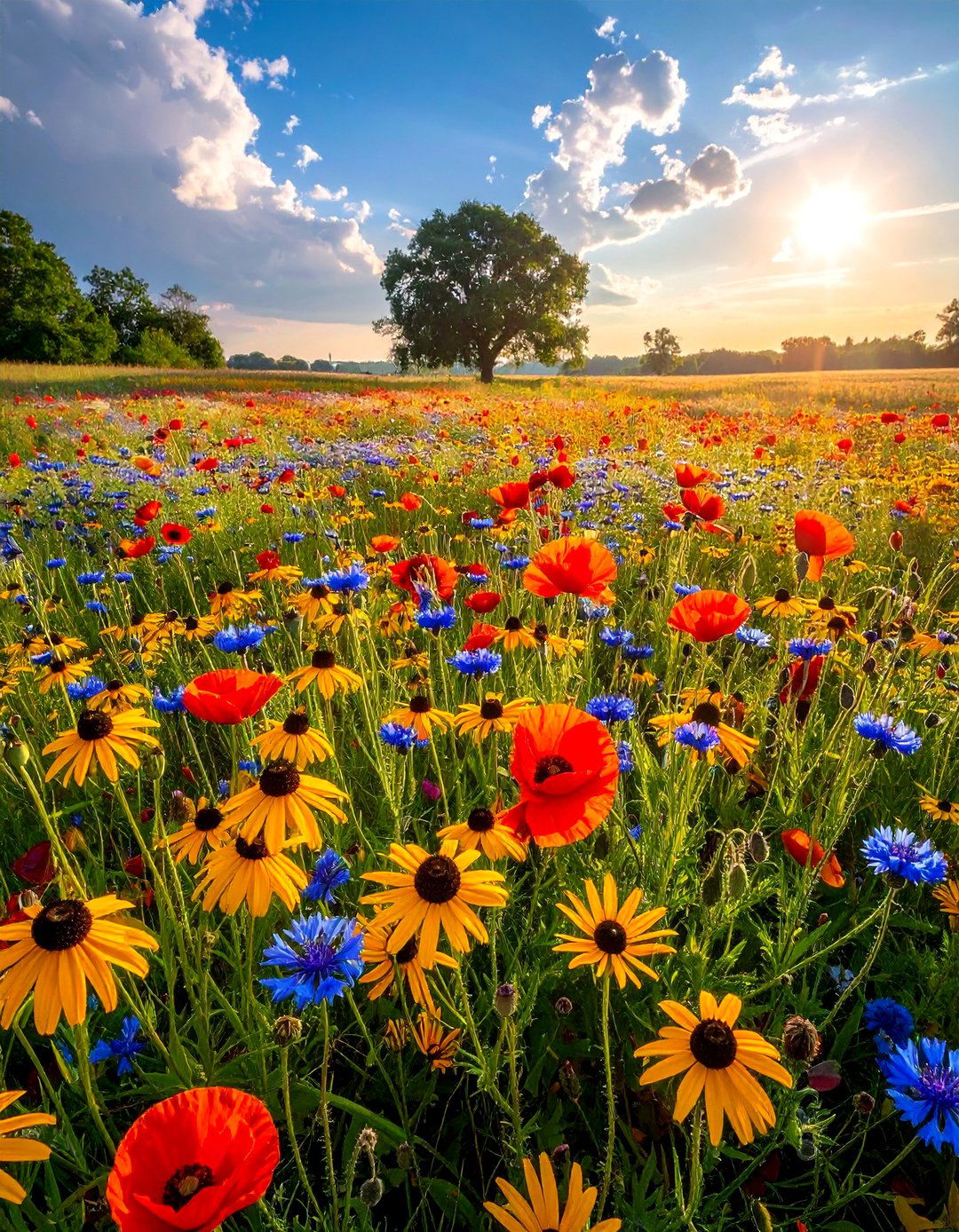
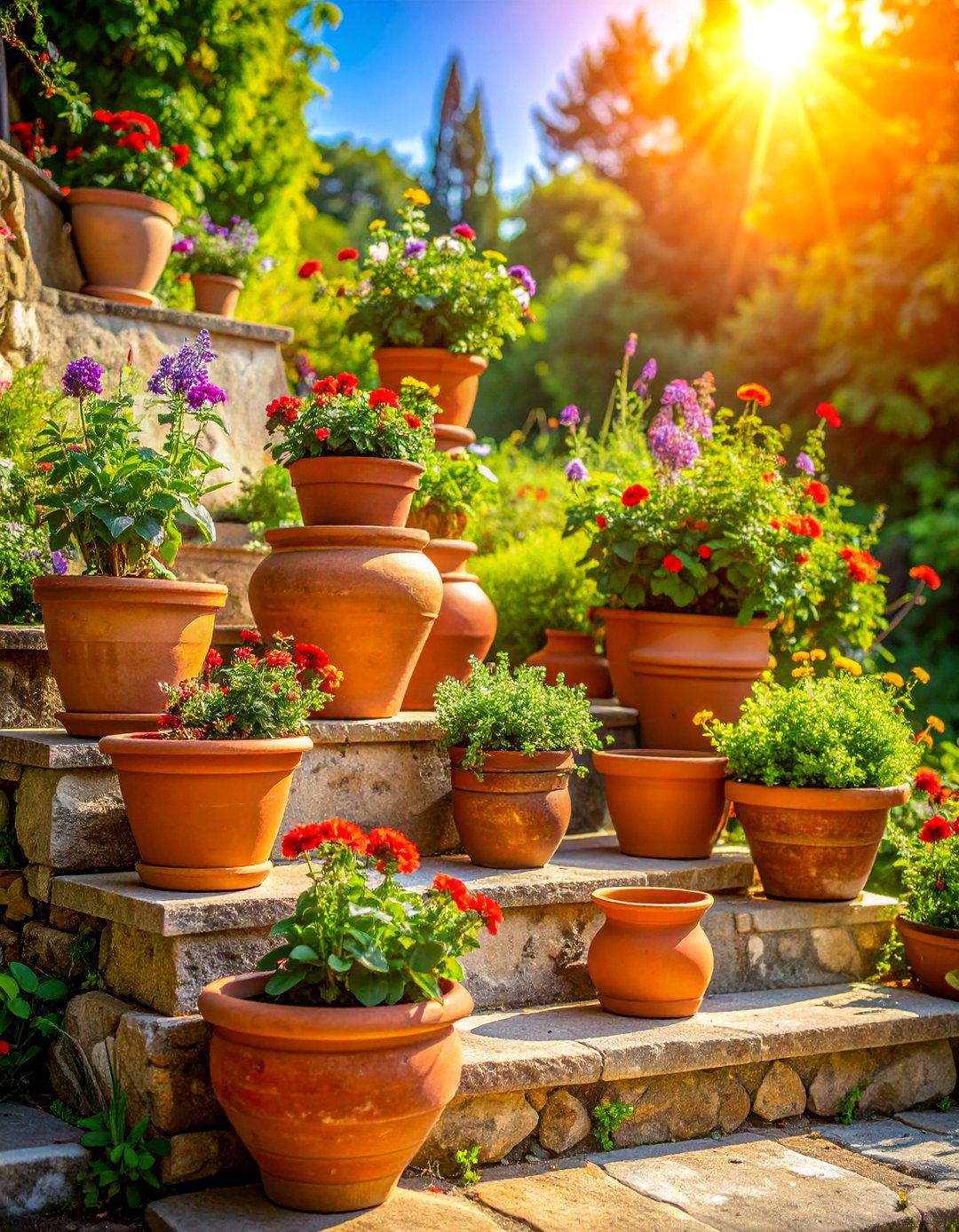
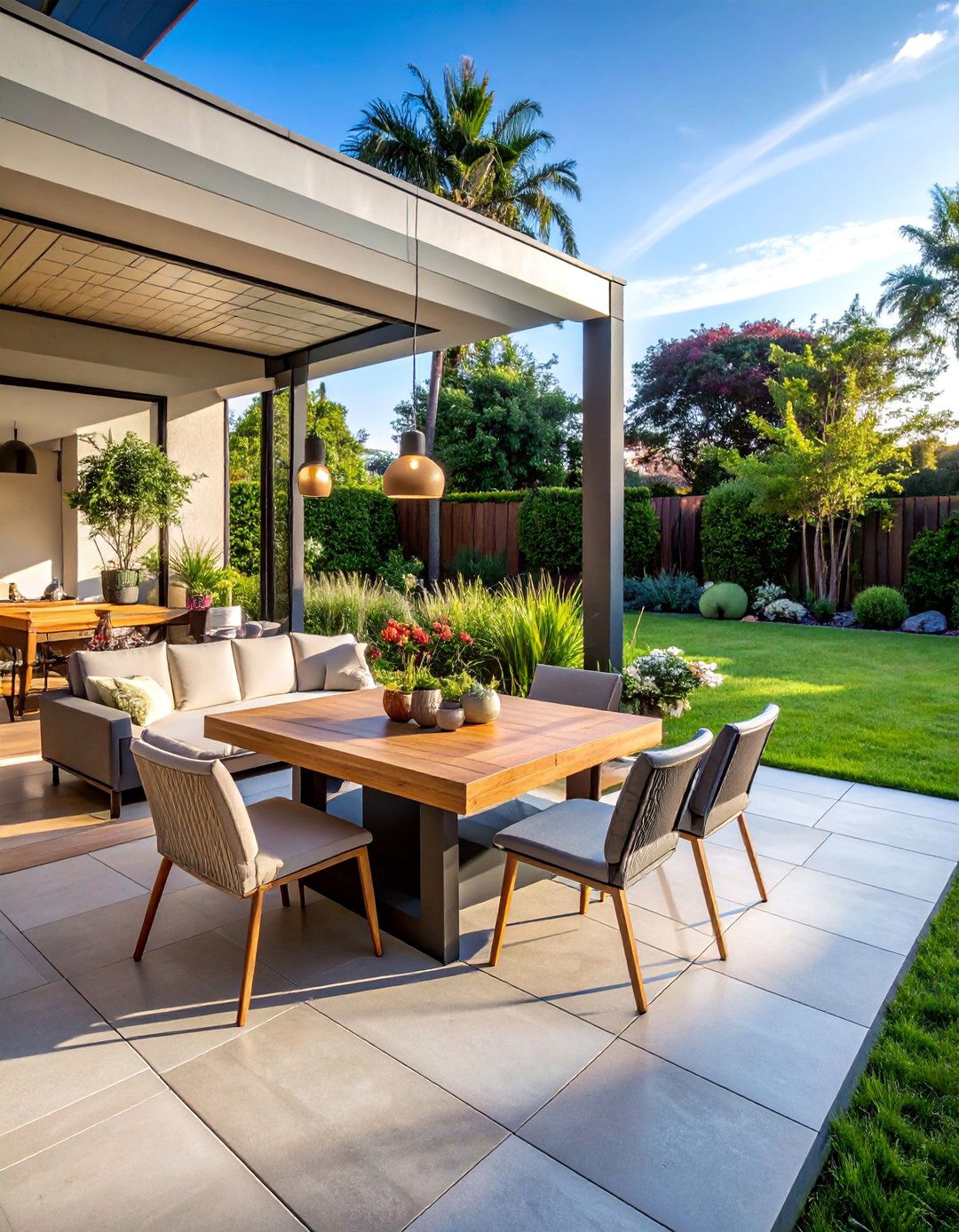
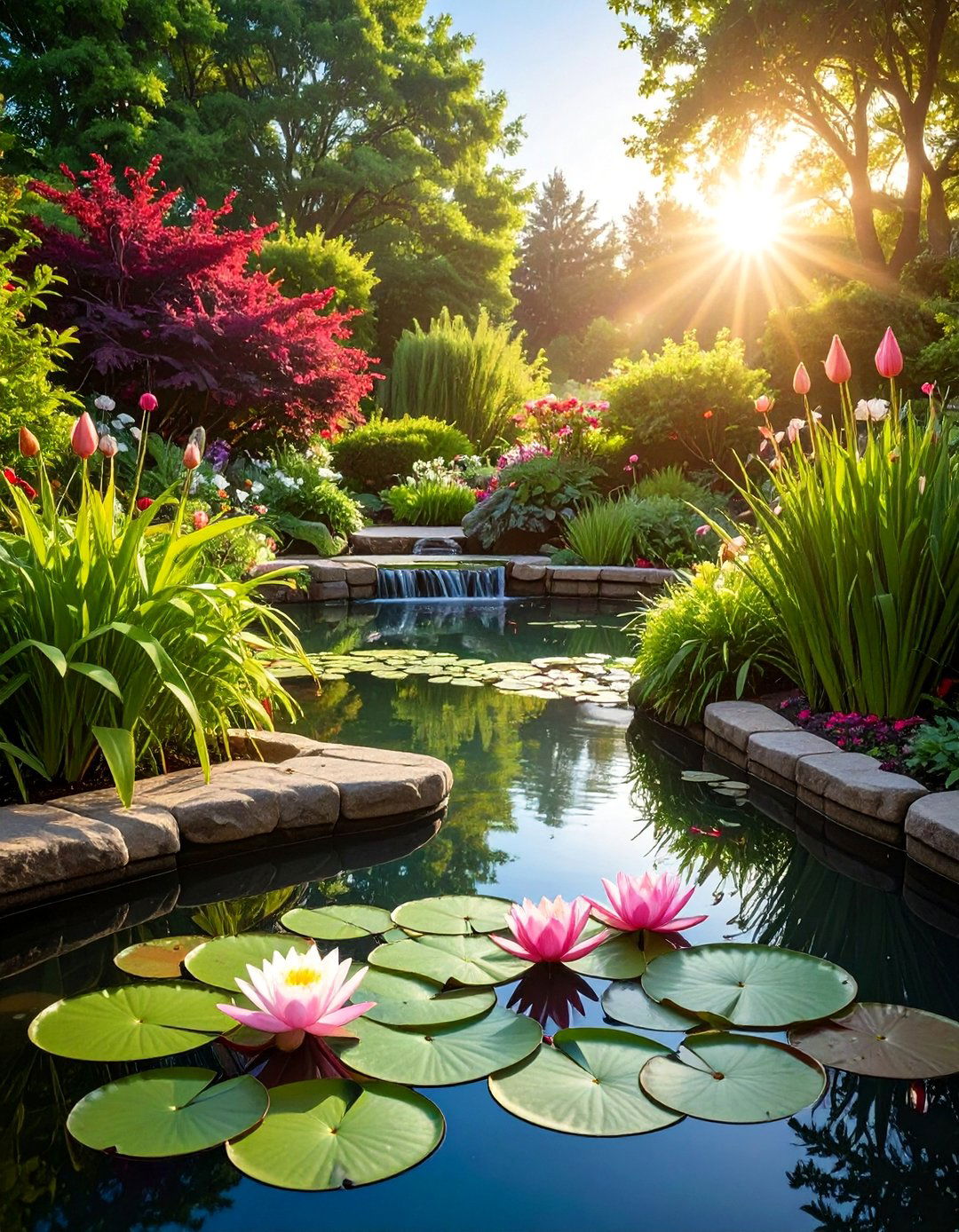
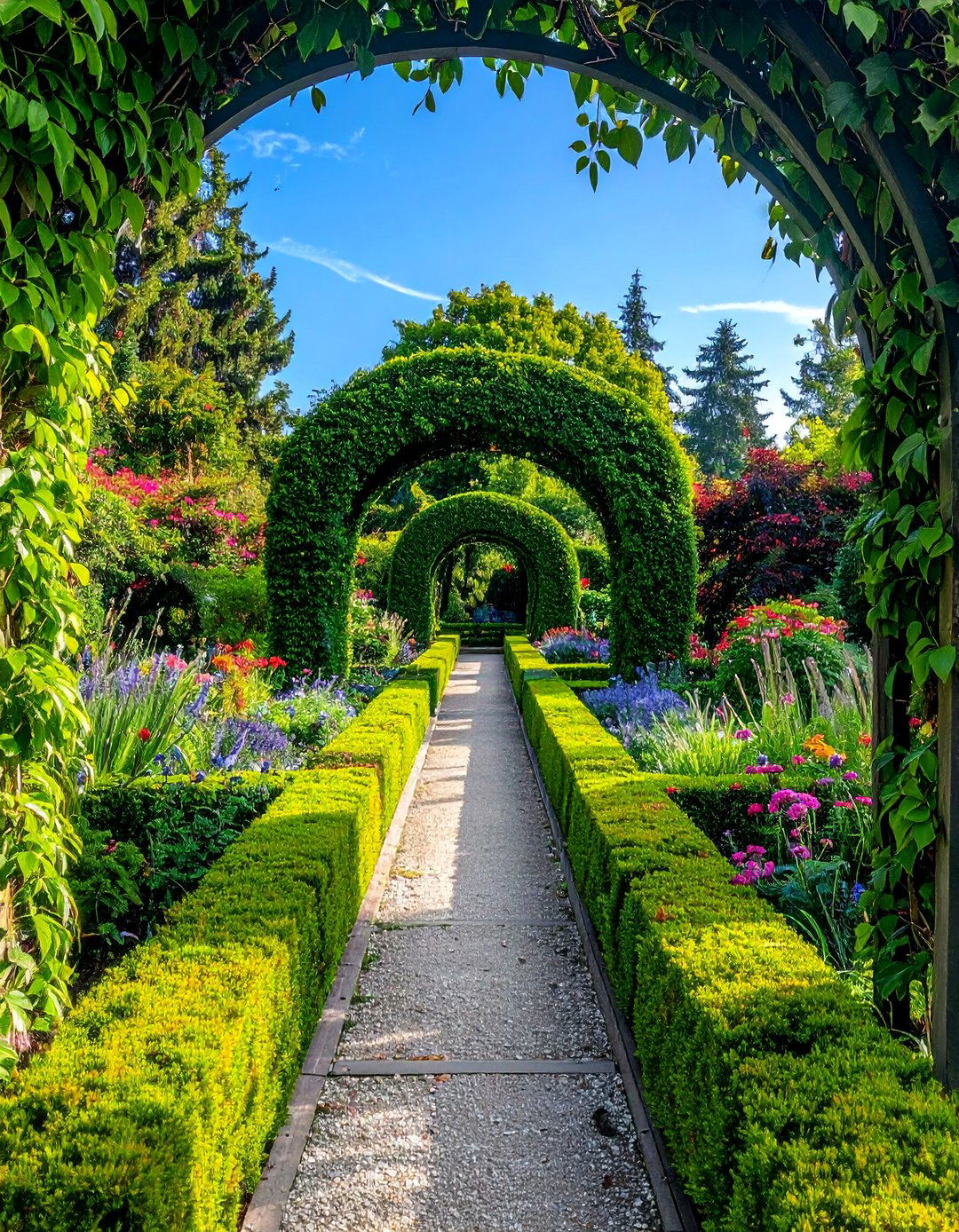
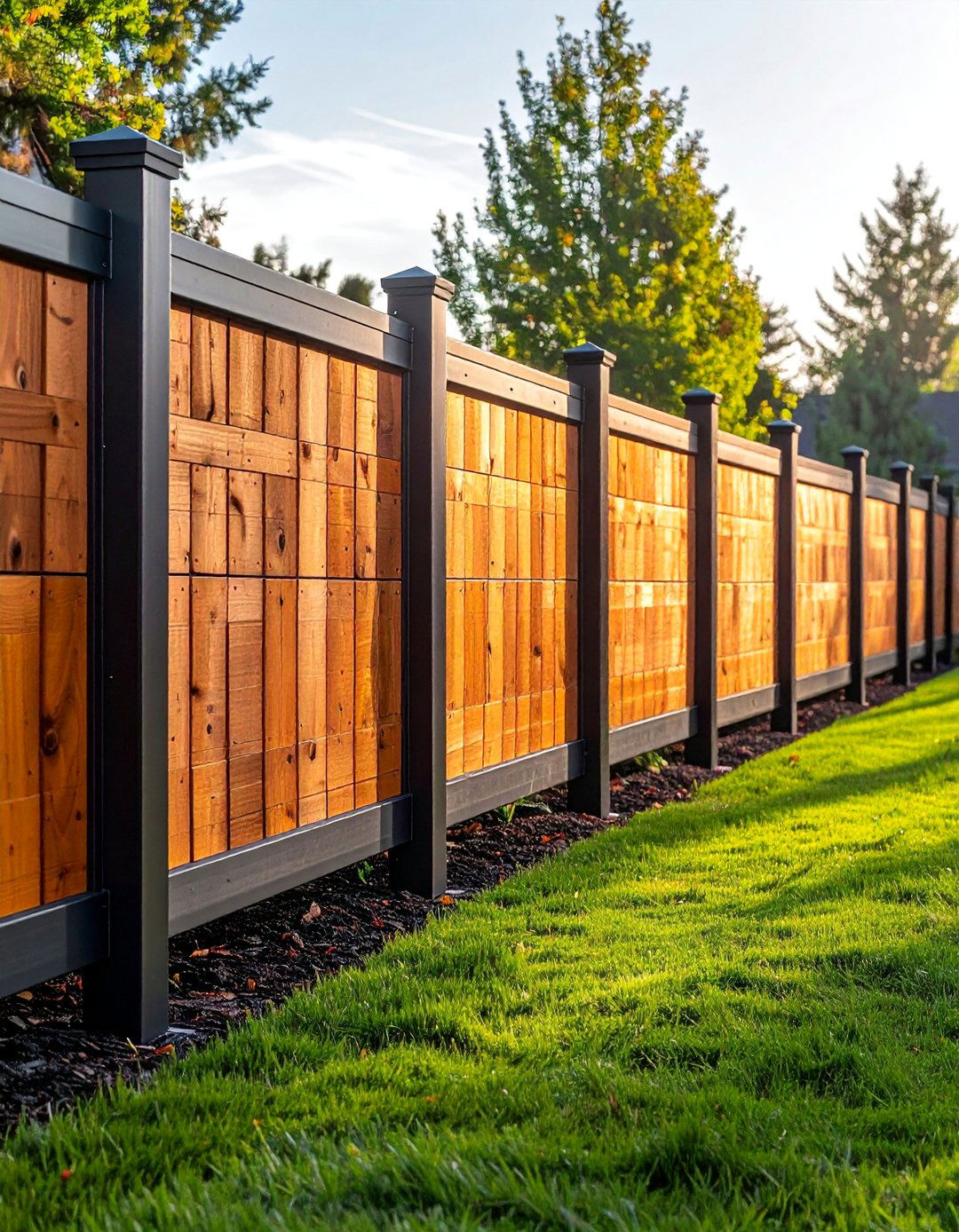
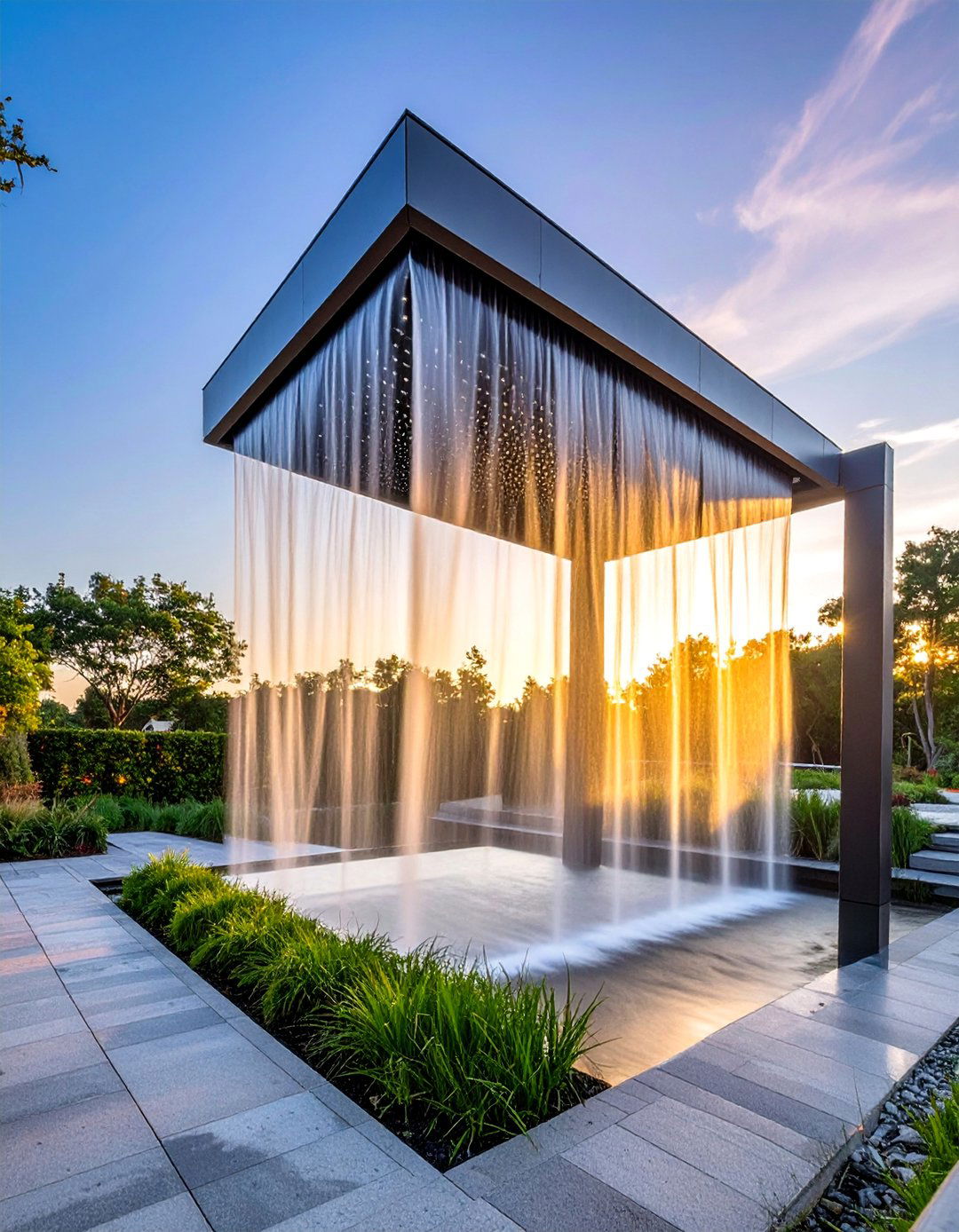
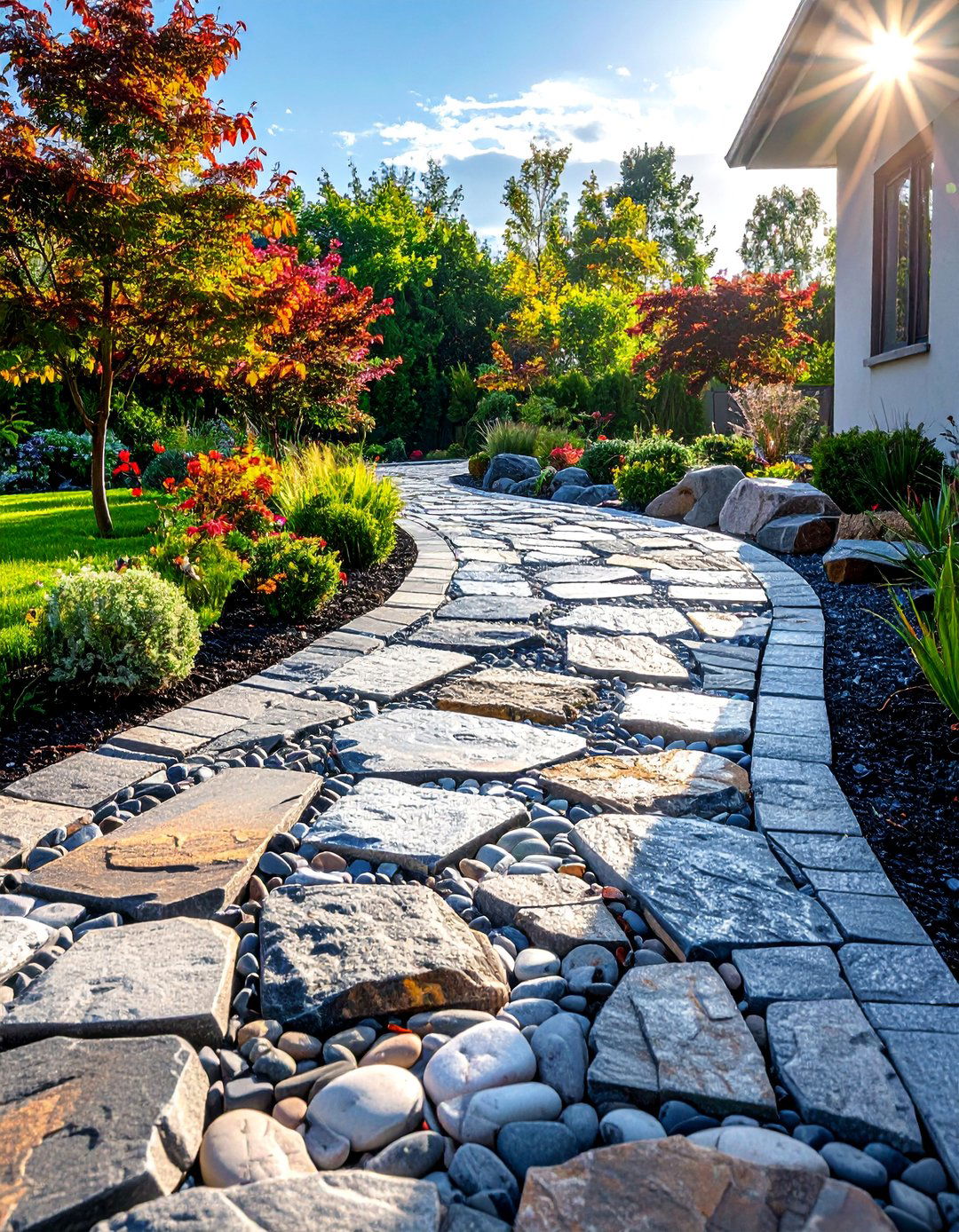
Leave a Reply